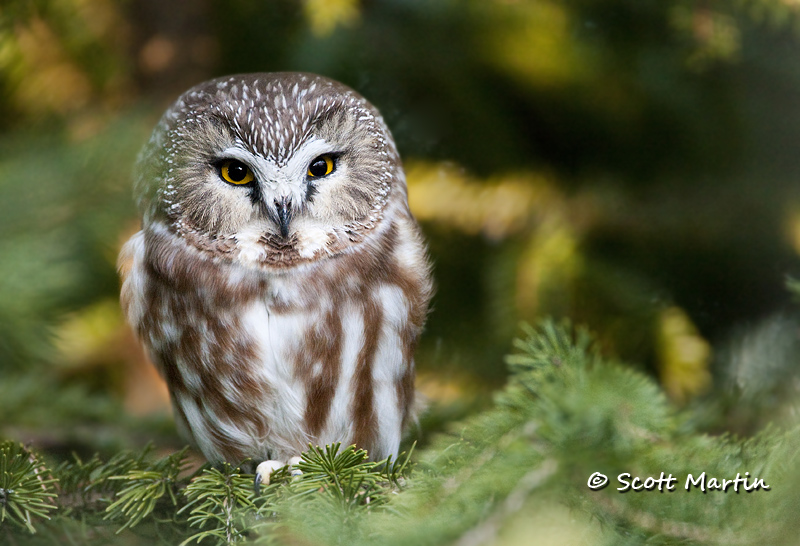
by Scott Martin Photography | Dec 30, 2017 | Birds, Blog, Educational, Raptors, Wildlife
The Survey Period Has Ended. Thank You For Your Interest.
Each year as the cold weather moves in and winter arrives, those of us who count ourselves as birders, photographers or a combination of thereof look forward to seeing owls, especially those that make their way south from the Arctic in search of food. In our area (Southern Ontario) the Snowy Owl is the most common followed by the Great Gray Owl and even more elusive Northern Hawk Owl.
It is also the time of year that the topic of discussion on many birding and photography forums as well as other social media platforms turns to the subject of baiting, specifically the baiting of raptors. These discussions are often emotionally charged and it has been my observation that little is accomplished by them.
If you search the literature there is not a plethora of information regarding baiting, especially with respect to the modes of baiting nor any objective parameters to even define what constitutes baiting. It is no wonder baiting discussions take the course they do.
The desire to gather information that will provide context for future baiting discussions became the genesis for this survey. It has been in development for a while and I greatly appreciate the input and edits suggested by five respected colleagues (including birders, conservationists and photographers) who reviewed the survey prior to its release.
The survey will remain open through January 31, 2018 with results available shortly afterwards. Please invite others to complete the survey and feel free to promote it among groups you interact with.
The Survey Period Has Ended. Thank You For Your Interest.

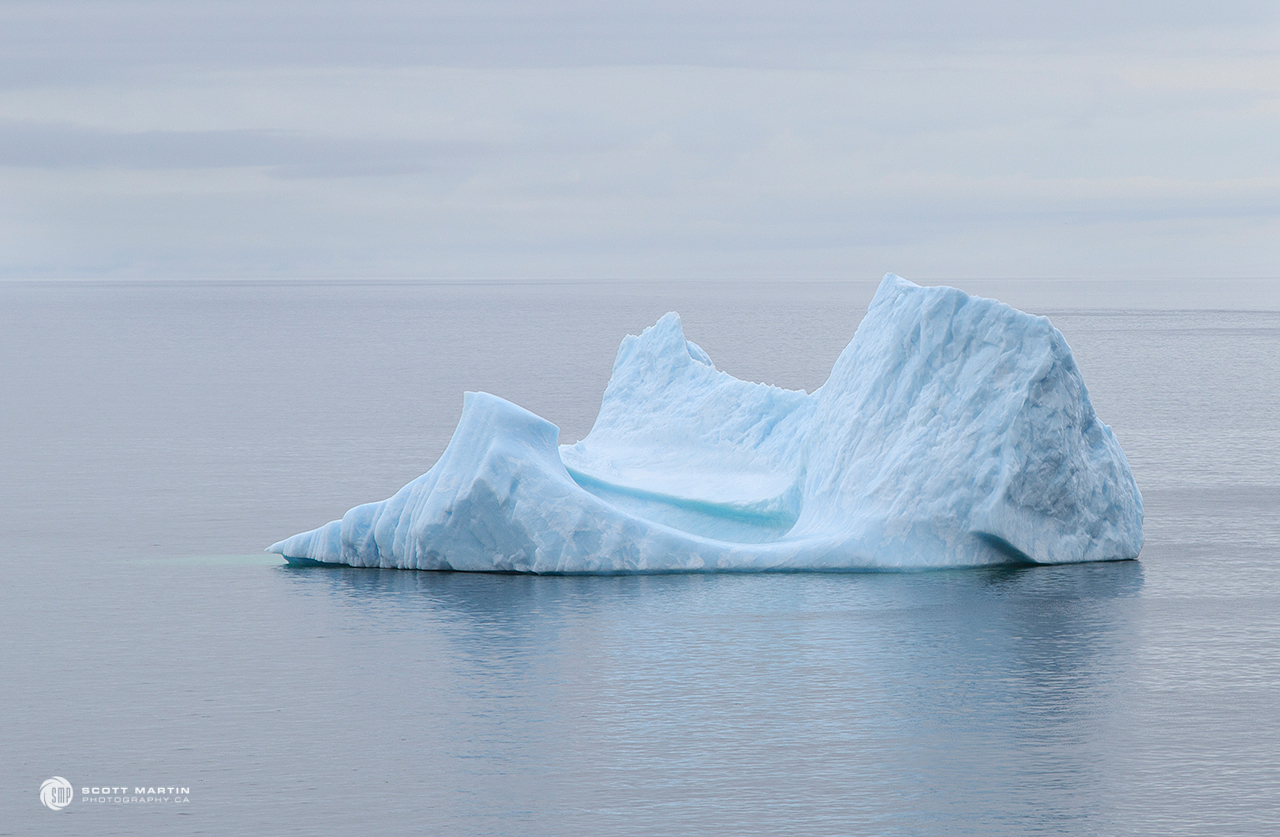
by Scott Martin Photography | Dec 5, 2017 | Blog, Landscapes, Naturescapes, Travel
This past summer Deb & I visited Newfoundland for the first time. It was a magical place to explore and happily we were able to see and photograph the wonderful geography, historic lighthouses and quaint villages as well as three unpredictable things we had hoped to see, namely icebergs, Puffins and whales.
This year was one of the best in recent memory to see icebergs in Newfoundland due to the large numbers present and how late into the summer the pack ice remained before breaking up and freeing the mighty icebergs to drift out to sea. This allowed Deb & I to see a few icebergs at the end of July, more than a month later than usual. We had planned the timing of our visit to see Puffins and whales which made the likelihood of seeing icebergs slim, however as we daily monitored IcebergFinder in the weeks prior to our trip we were excited to find that we just might see some. (Bookmark the IcebergFinder link if you ever plan to visit Newfoundland and want to know where the icebergs are).
While staying in Twillingate, part of the region known as Iceberg Alley along the North Coast of the island, we heard a large iceberg was just a few kilometres away in Crow Head. Neither Deb nor I had ever seen an iceberg and will never forget the feeling of cresting a hill heading into the village and seeing a huge iceberg sitting majestically just off shore. I had to stop the car and take a pic 🙂
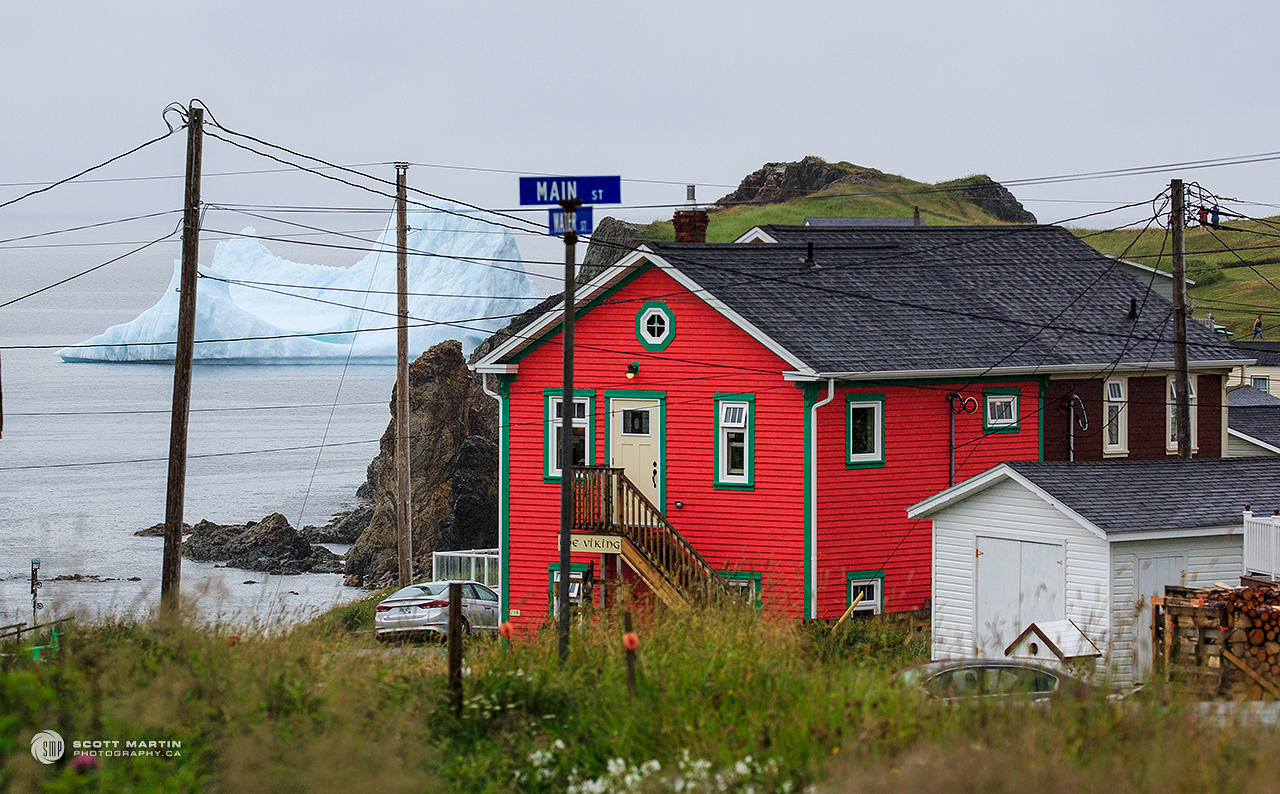
We quickly made our way to a great vantage point to see and photography the iceberg.

Icebergs are formed when they calve off a glacier and typically survive for three to six years before passing out of existence. Most icebergs in Newfoundland are formed when they break off glaciers in Greenland and currents take them southwest where they encounter the Labrador Current which they follow until they physically break apart due to the erosive action of the wind and waves or simply melt as they stray into warmer waters.
We were thrilled to see a Minke whale slowly swim behind the iceberg and give a bit of context to the size of the iceberg. Minke Whales are up to 30′ long and the locals were saying the iceberg was 200′ wide and 75′ high. It was grounded in 580′ of water! Take note of the iceberg water level in this picture and compare it with the images to follow.
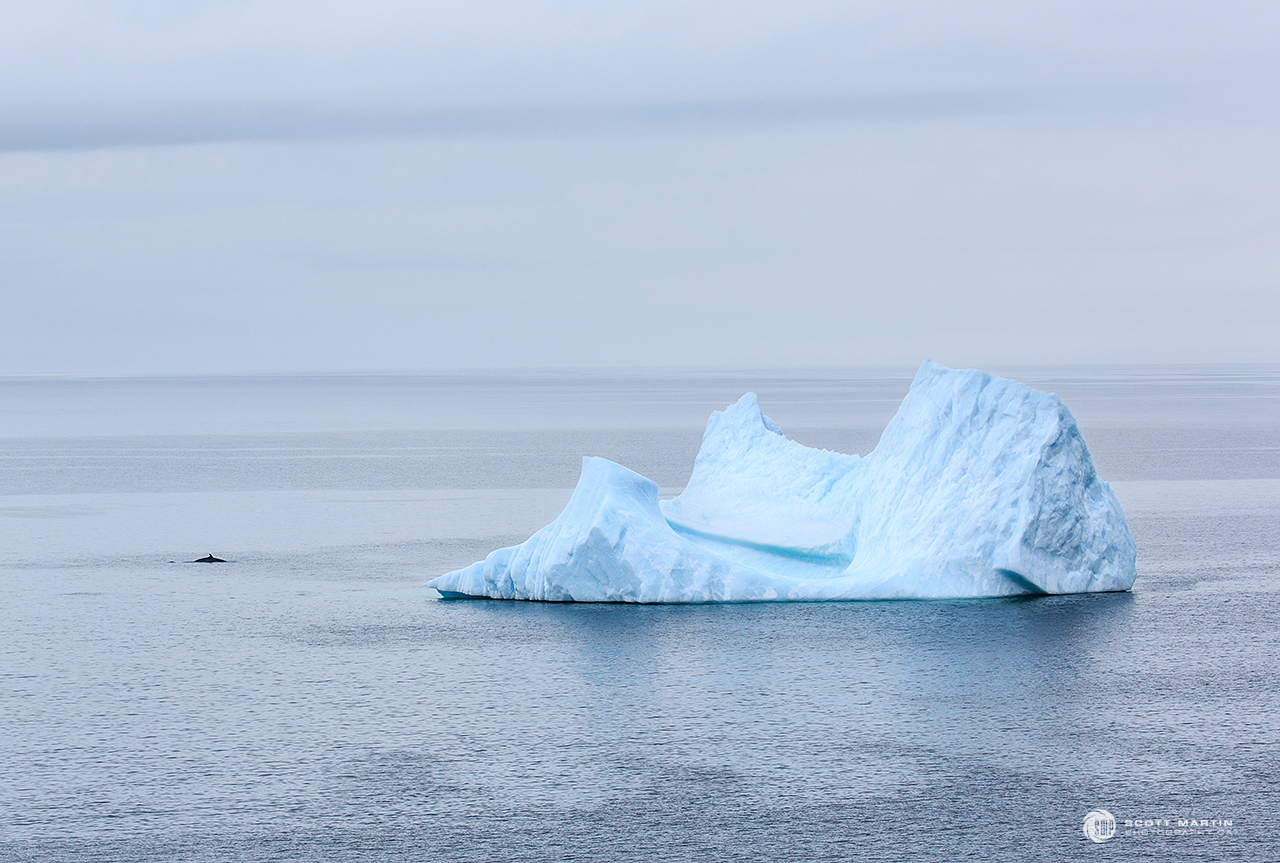
These two kayakers, much braver than Deb or I, also provide some context, but have you noticed the changing water levels….the iceberg was destabilizing and starting to roll!
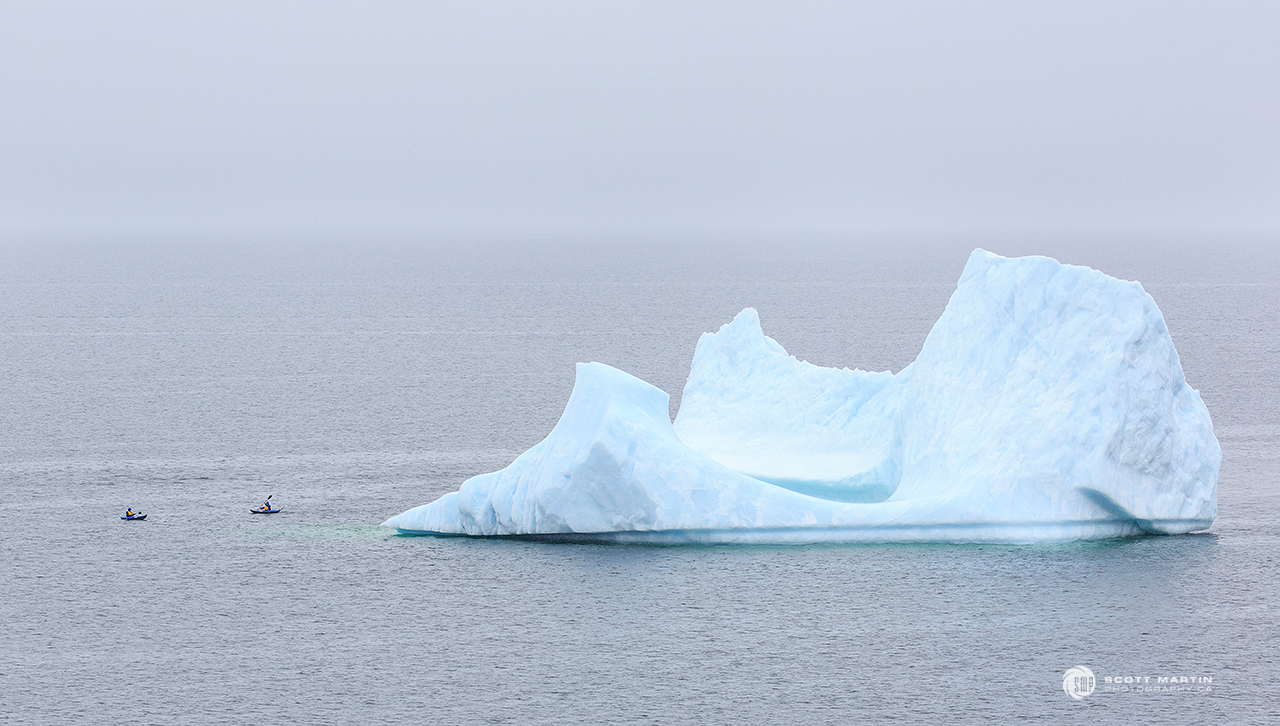
As the iceberg moves, the weight distribution is altered which can cause the iceberg to fragment as seen in this next image. The sound of ice breaking away from the iceberg and splashing into the water is like nothing we had ever heard; like the combination of a rifle shot with thunder.
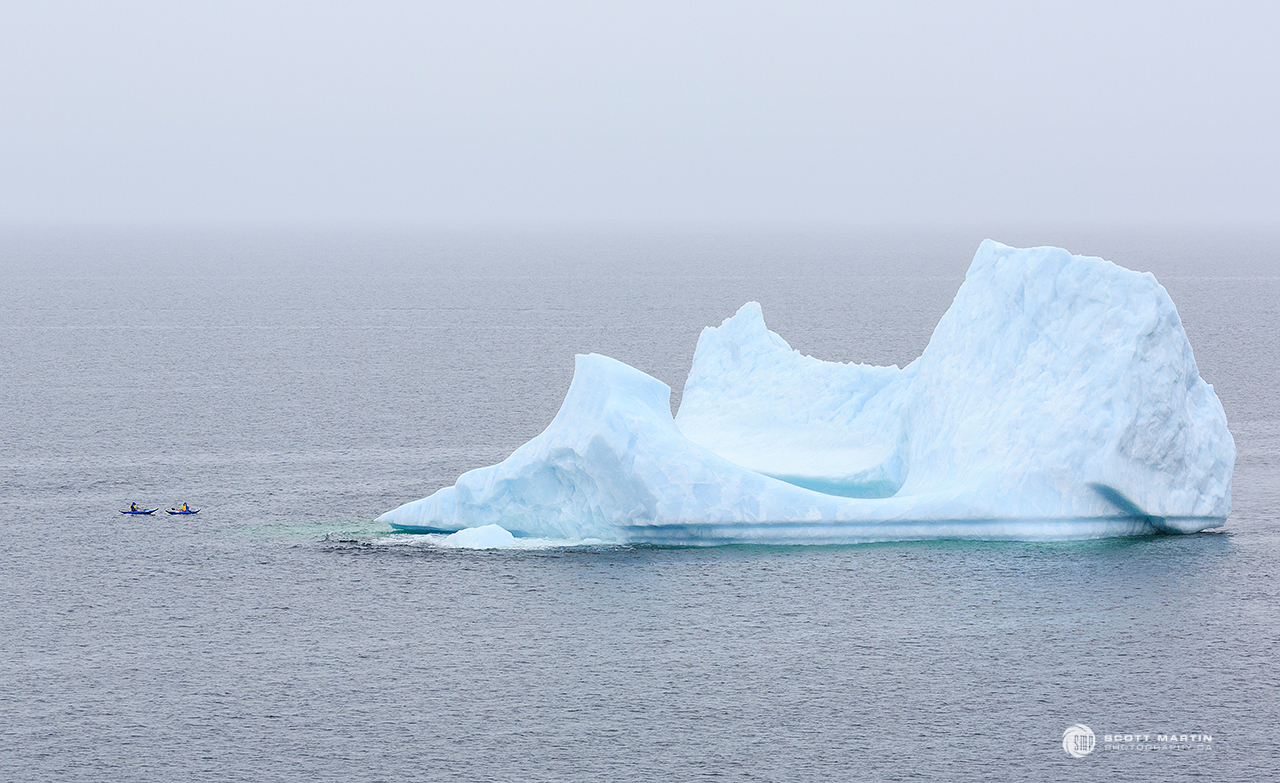
Once the iceberg began to fragment, the process continued and less than five minutes after the first piece of ice fractured and even larger segment fell off the back of the iceberg. Check the water level marks and note how much the ice mass was moving.
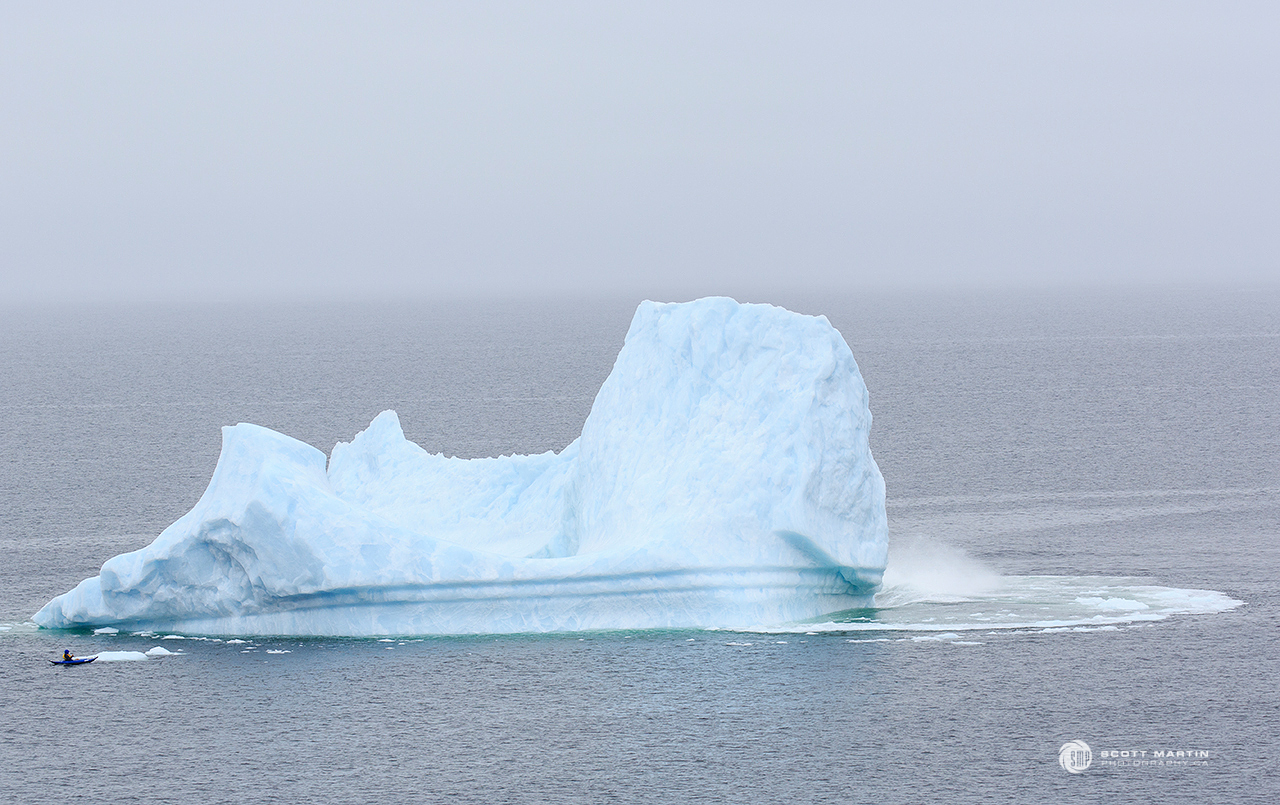
I can only imagine what it would have been like to be in a kayak while an iceberg was breaking up around me!
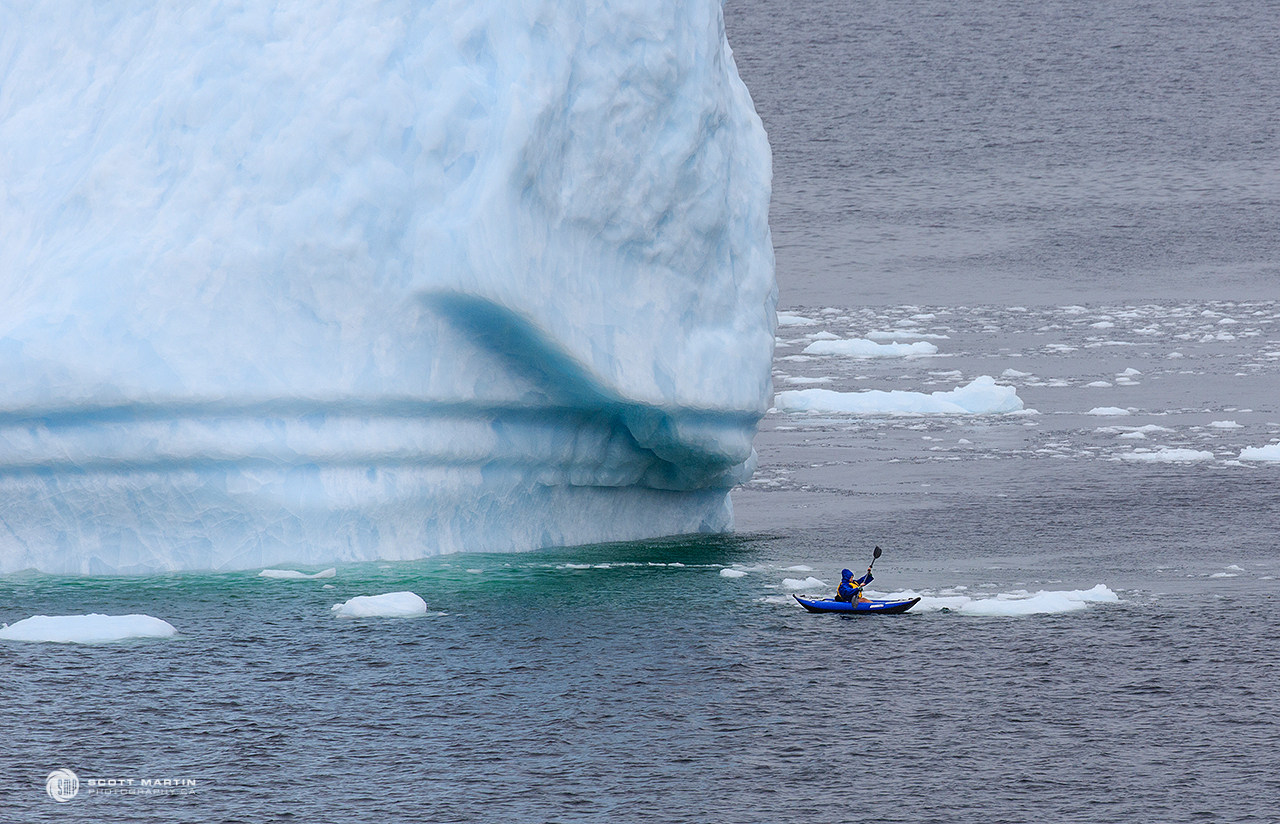
Although we didn’t try a kayak, we connected with Iceberg Man Tours in Twillingate for a two hour cruise highlighted with a visit to the iceberg. Captain Cecil was terrific and we learned so much about Newfoundland, the culture, the whales and the icebergs during our cruise. Captain Cecil is a retired teacher, who grew up in Twillingate, served as mayor of Twillingate and started Iceberg Man Boat tours in 1985. Cecil knows Newfoundland!
The little village of Crow Head, NL as seen from amongst ice fragments around the iceberg.
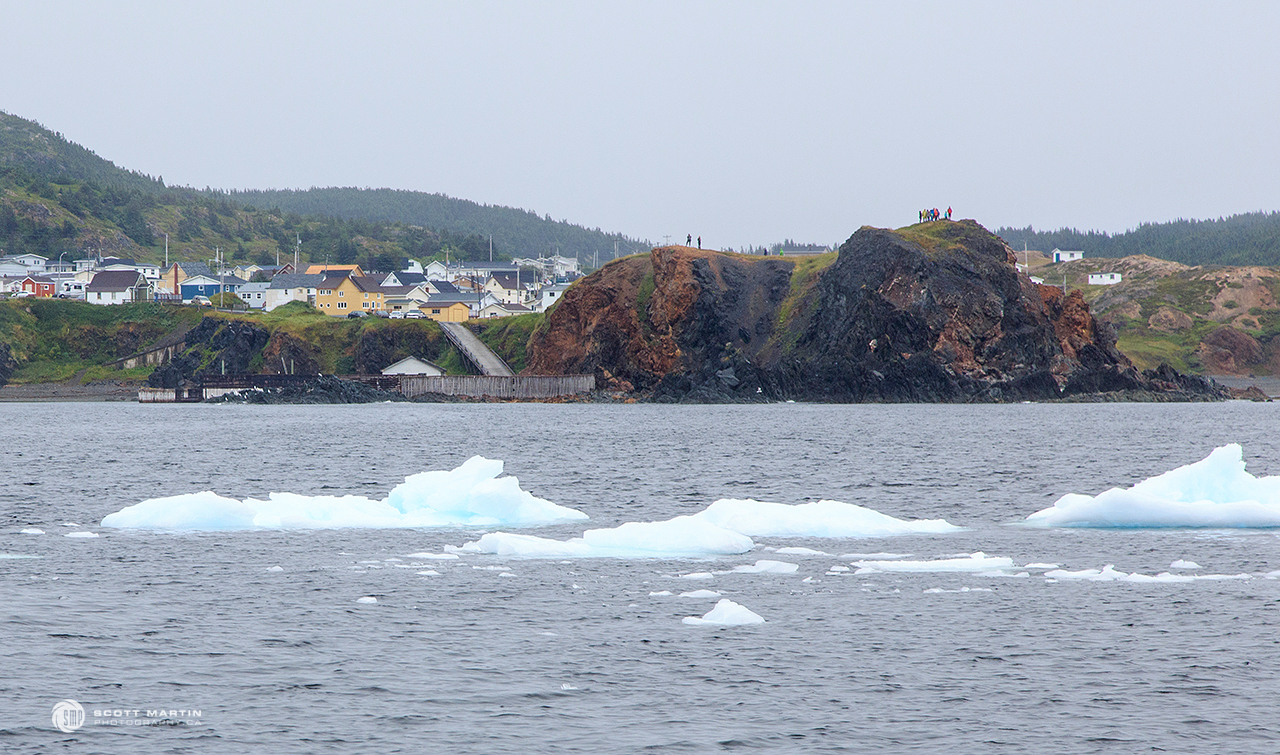
We circled around the iceberg a number of times, taking more than 500 images of it from every conceivable angle. It was hard to put the camera down!
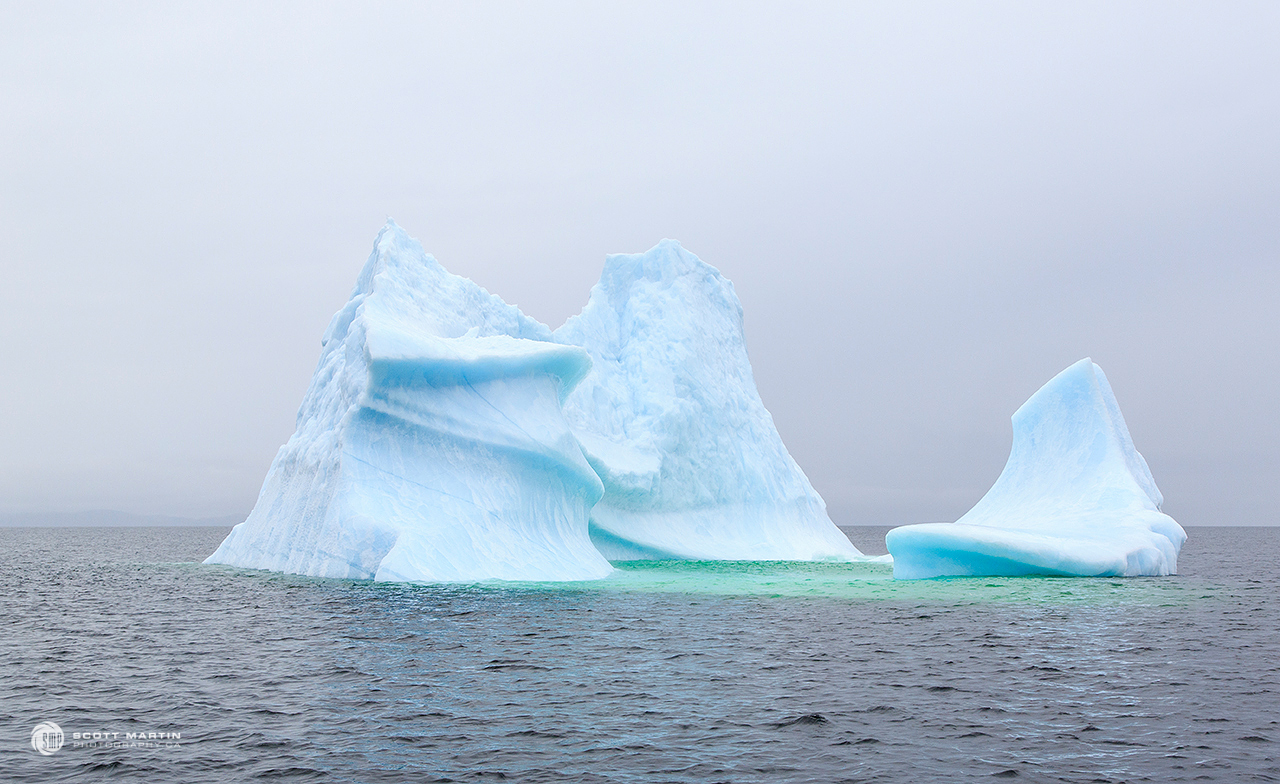
.
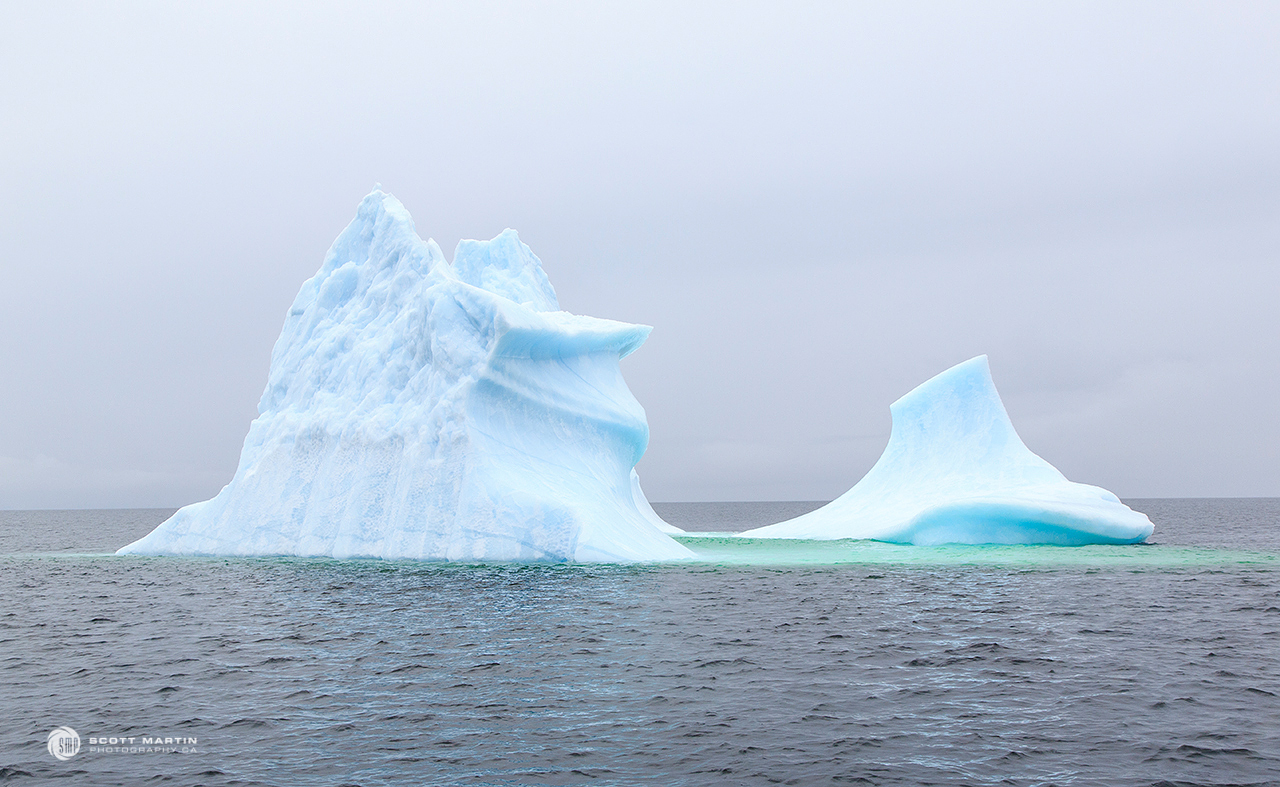
Like modern pieces of art.
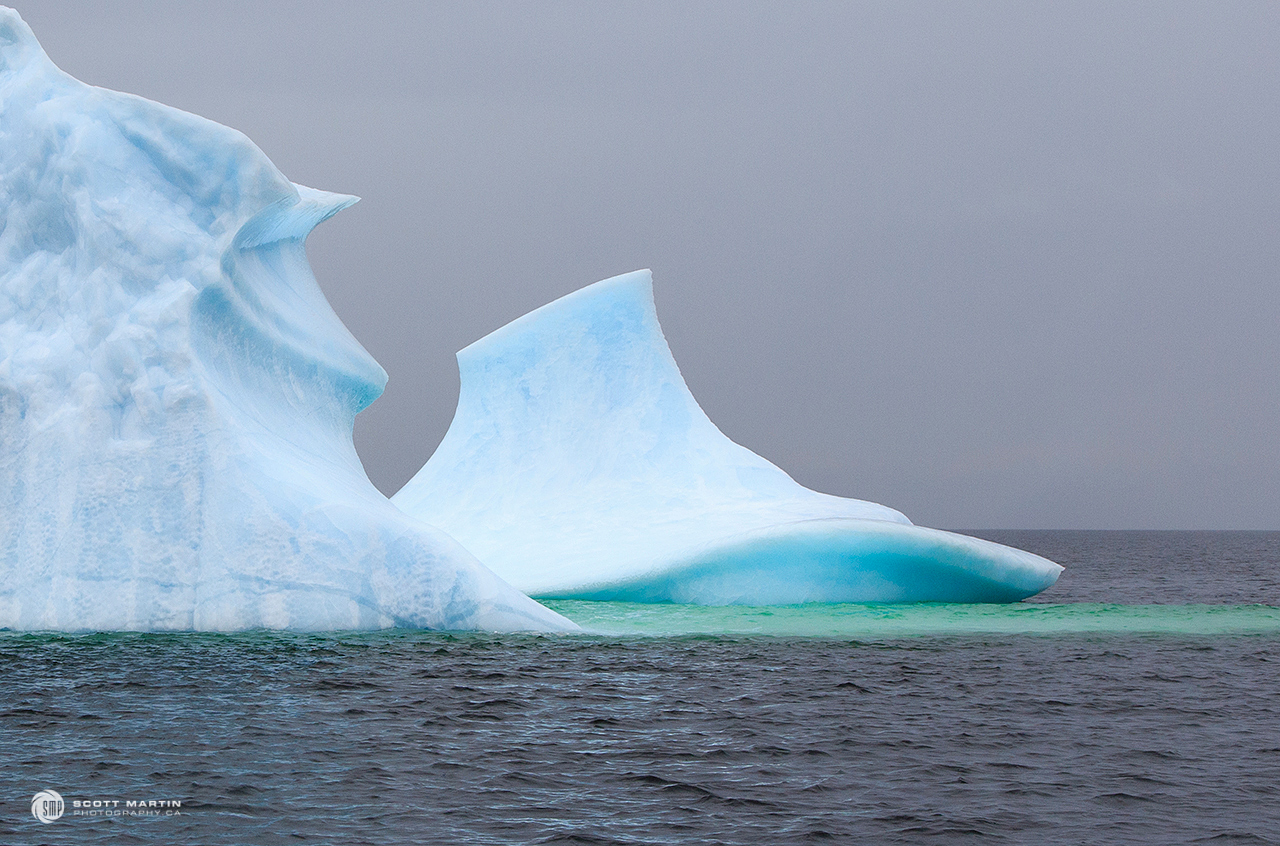
The approaching ship provides an interesting size perspective for the next image.
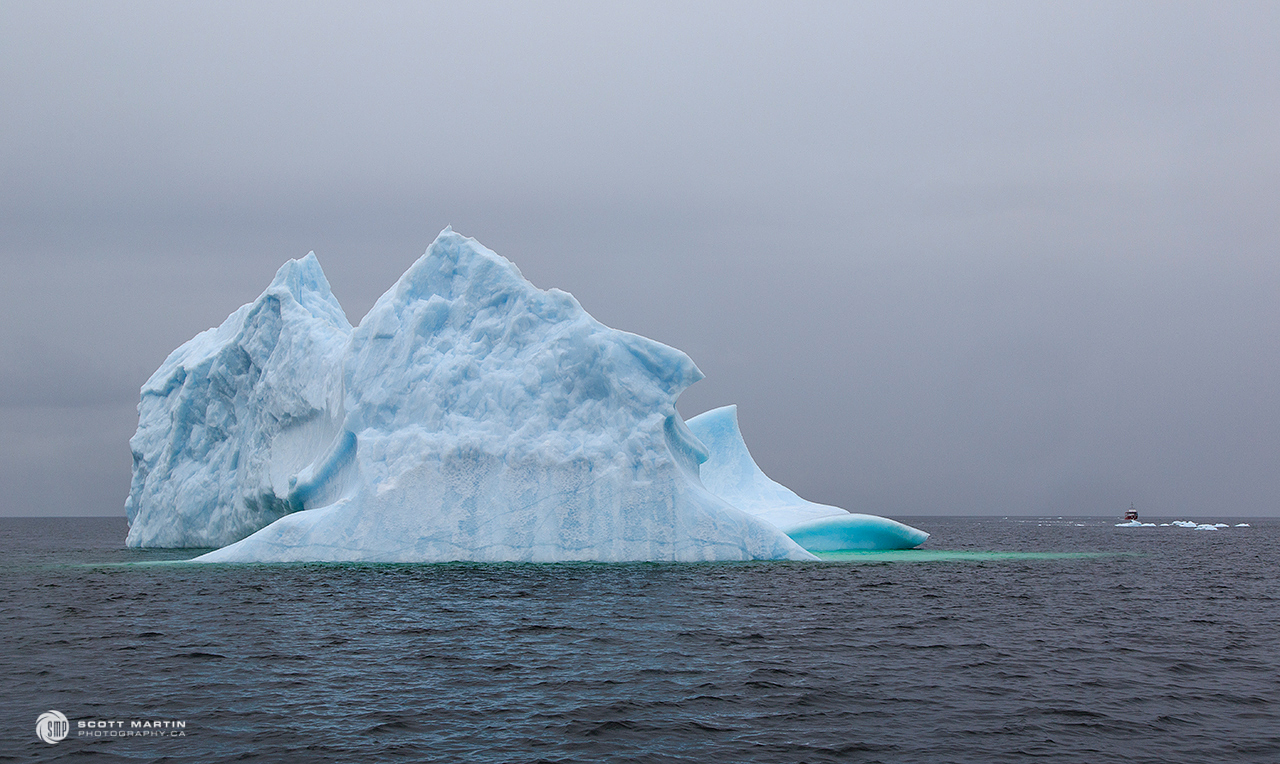
.
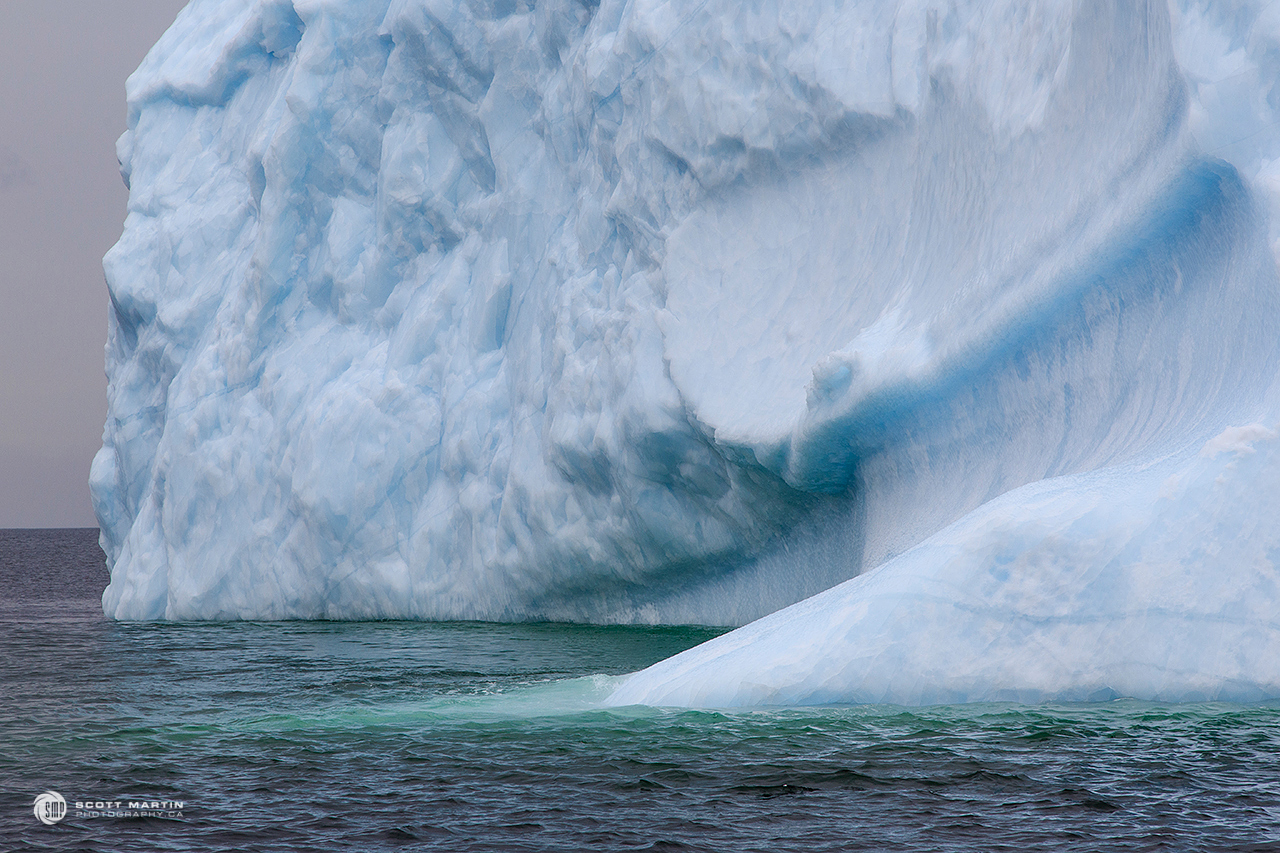
After returning to Captain Cecil’s dock in Twillingate and enjoying dinner in a little restaurant on the edge of the harbour we headed back to Crow Head to watch the sunset and see the iceberg one last time. Although we couldn’t frame the sun setting over the iceberg from the mainland, we did enjoy the colours and the new look they gave the iceberg. It was remarkable how much the iceberg had changed in ten hours.
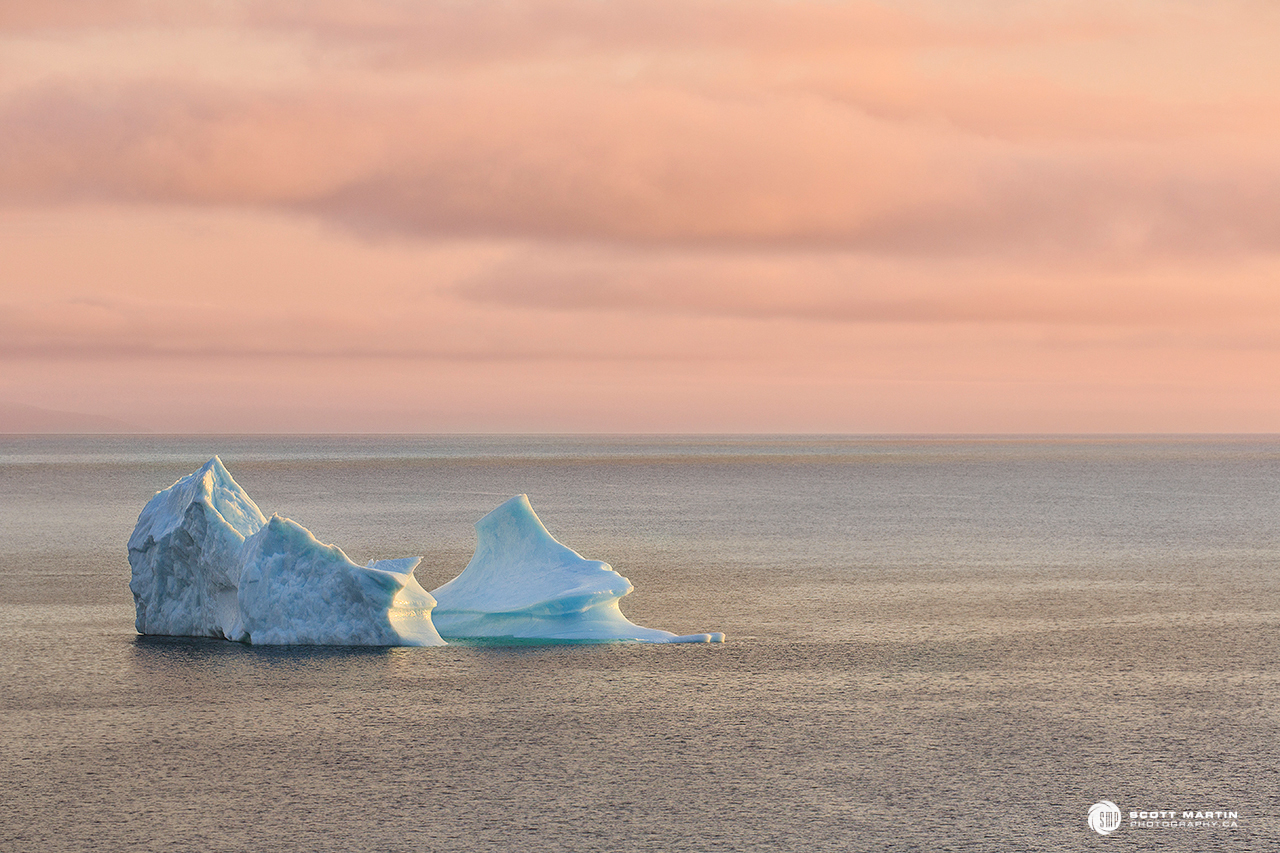
As the sun went down we were chatting with another couple and their daughter and it turned out the father & daughter were the two kayakers from earlier in the day! Ironically, as they were saying they felt more awe than fear as the large chuck of ice fell from the iceberg close to their kayaks, a loud rife sounding noise came from the iceberg and the entire iceberg began to pitch and roll quite drastically. By this time it was about thirty minutes after sunset and it was quite dark, however I just had to take some images, even though an ISO of 8000 was required.
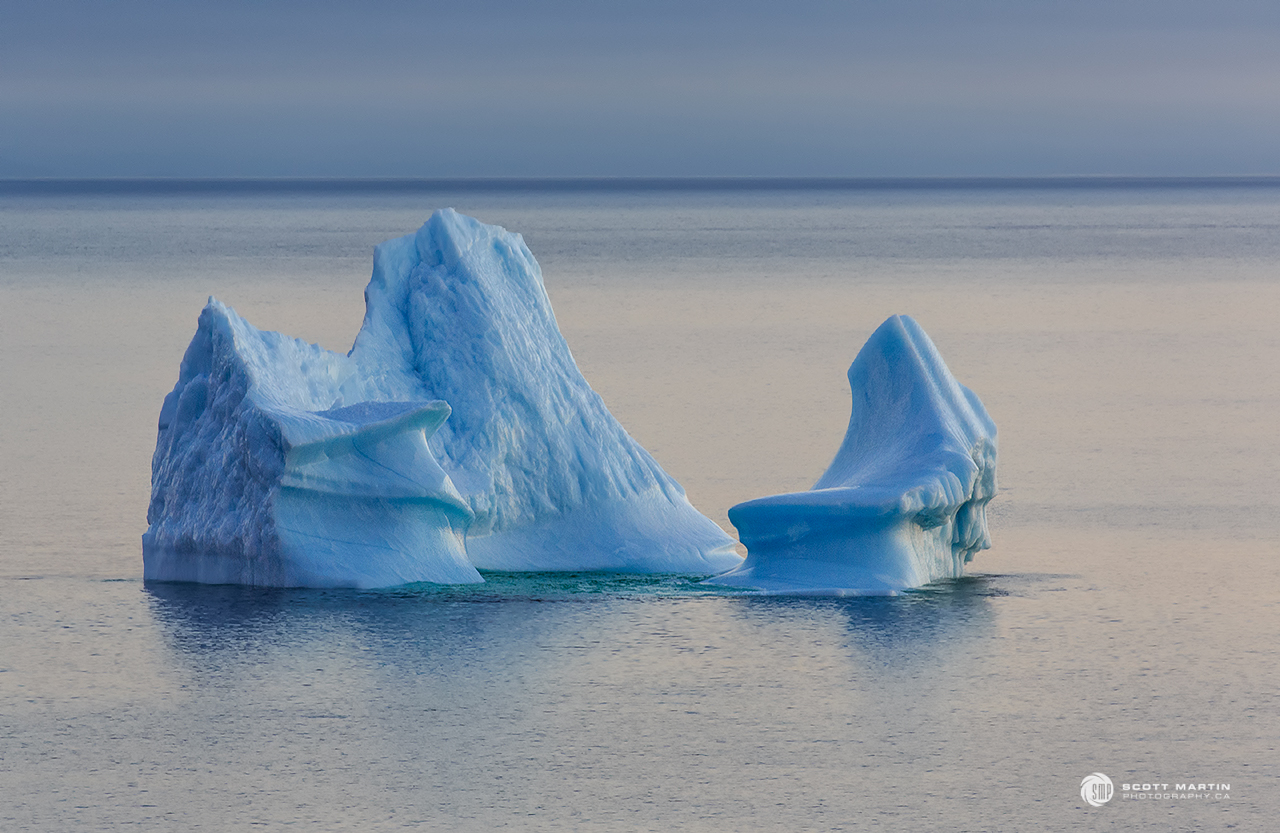
The iceberg slowly begins rotating in a clockwise direction.
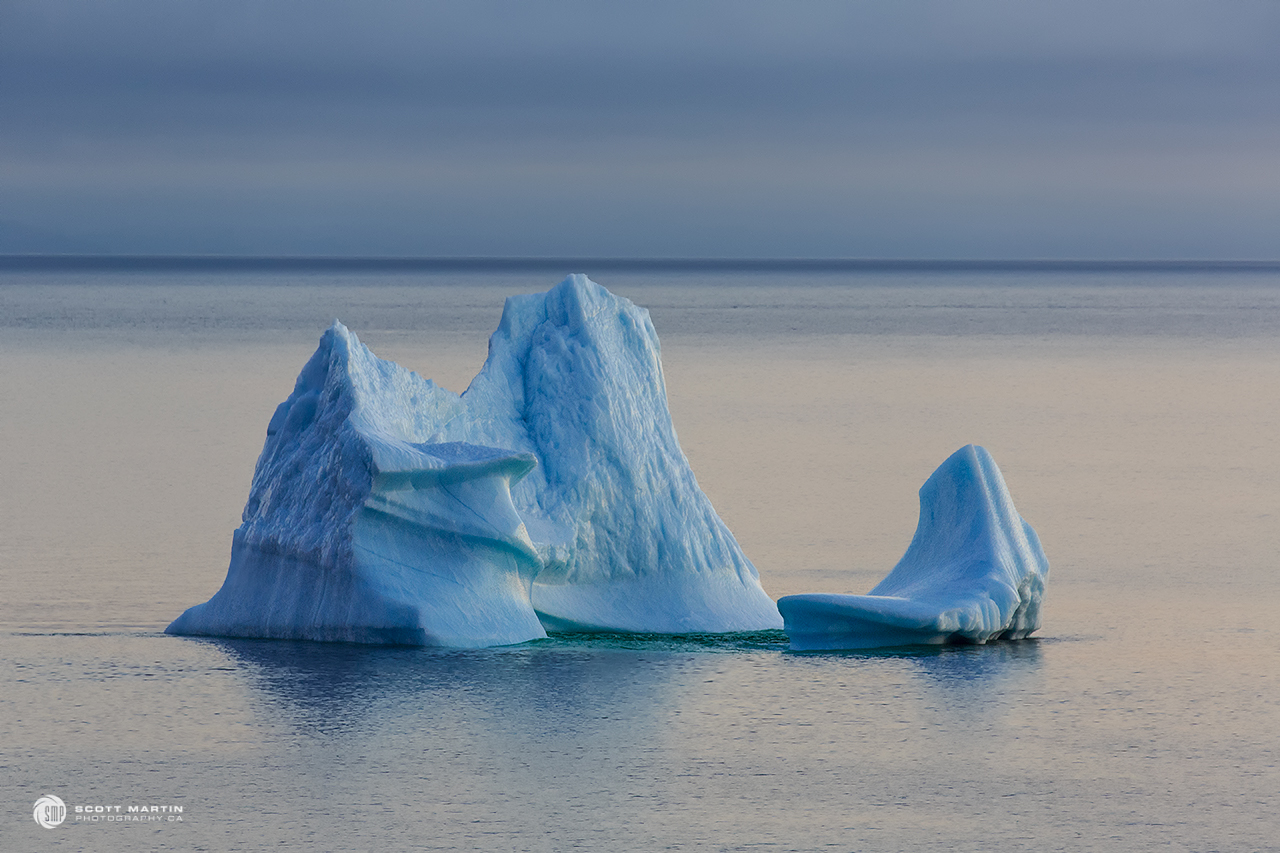
.
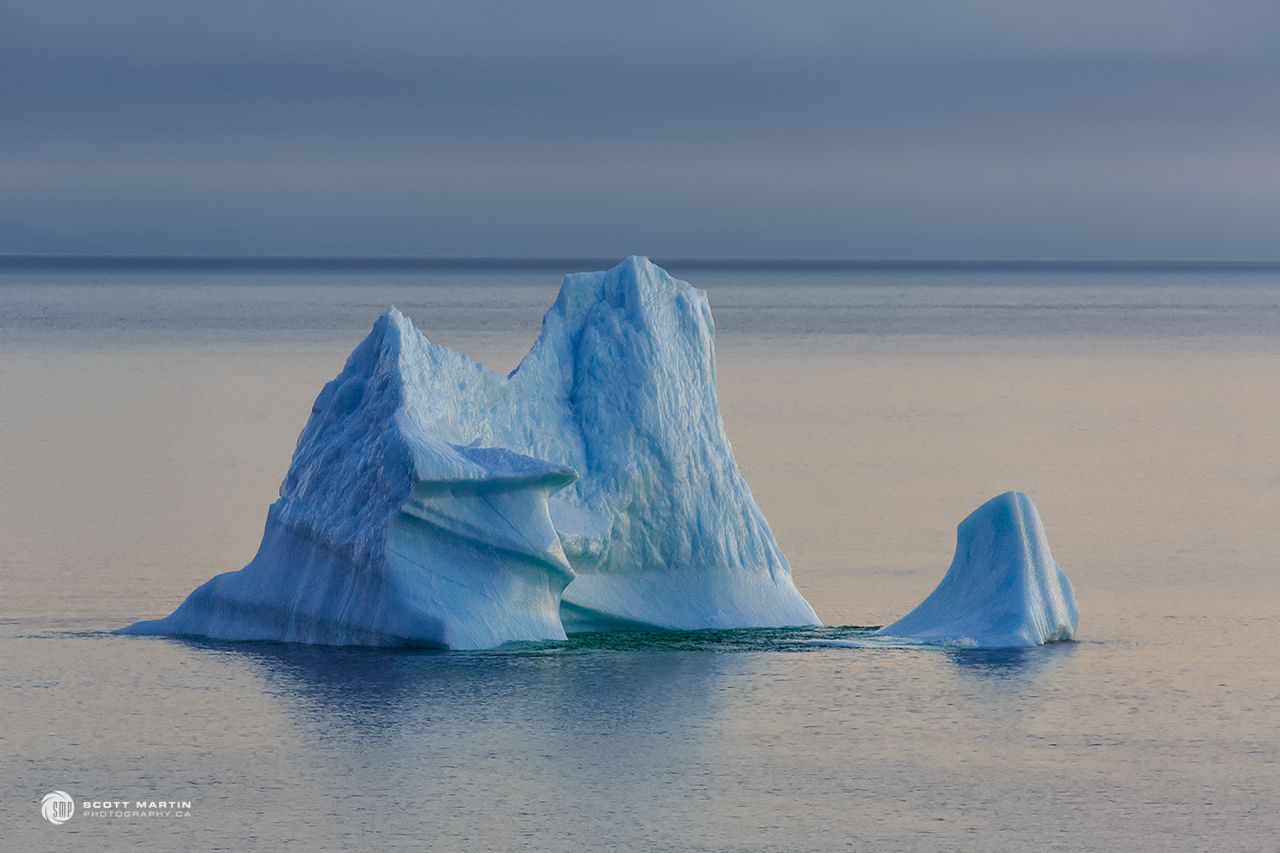
.
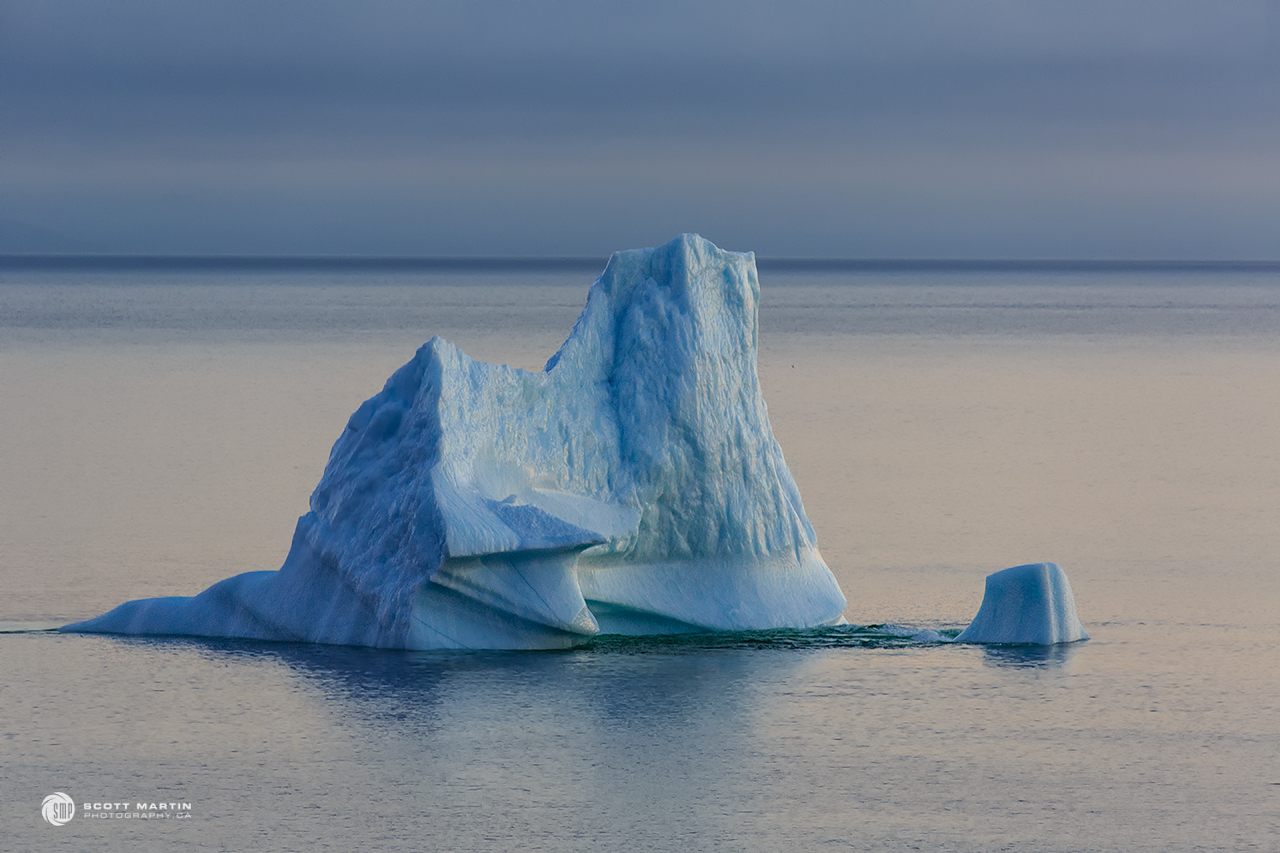
The beautiful modern art looking section of the iceberg is about to disappear forever.
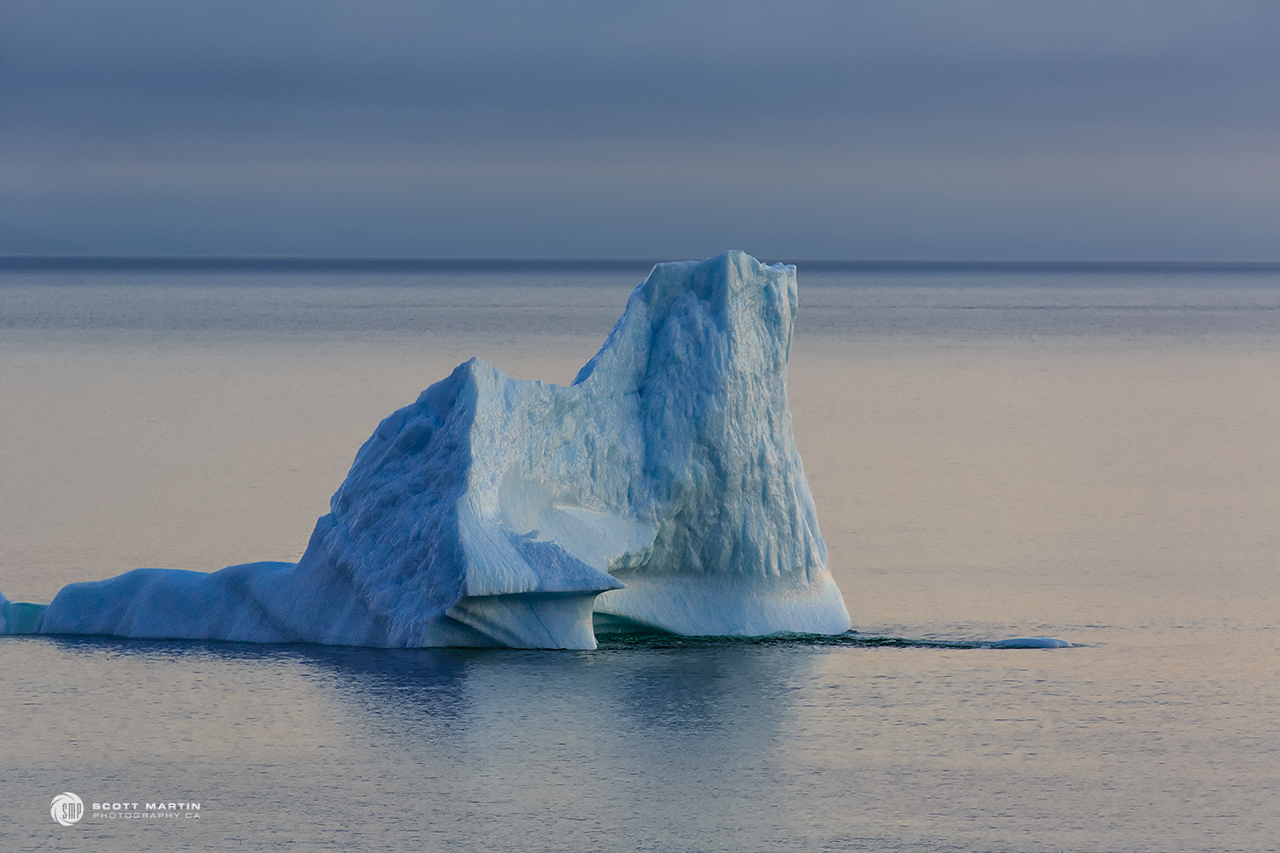
As the iceberg rotates a whole new mass of ice appears on the left side. This section was about 100′ in length.
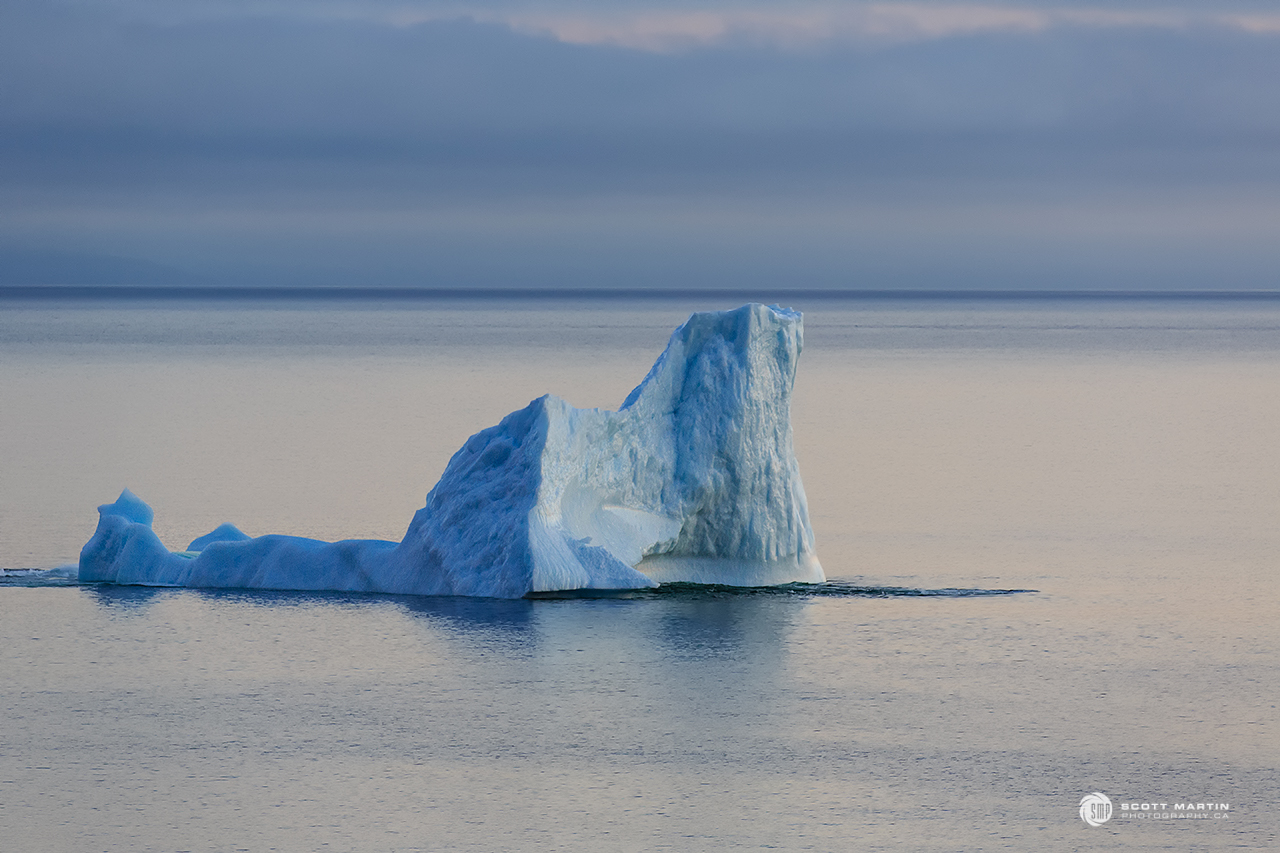
.
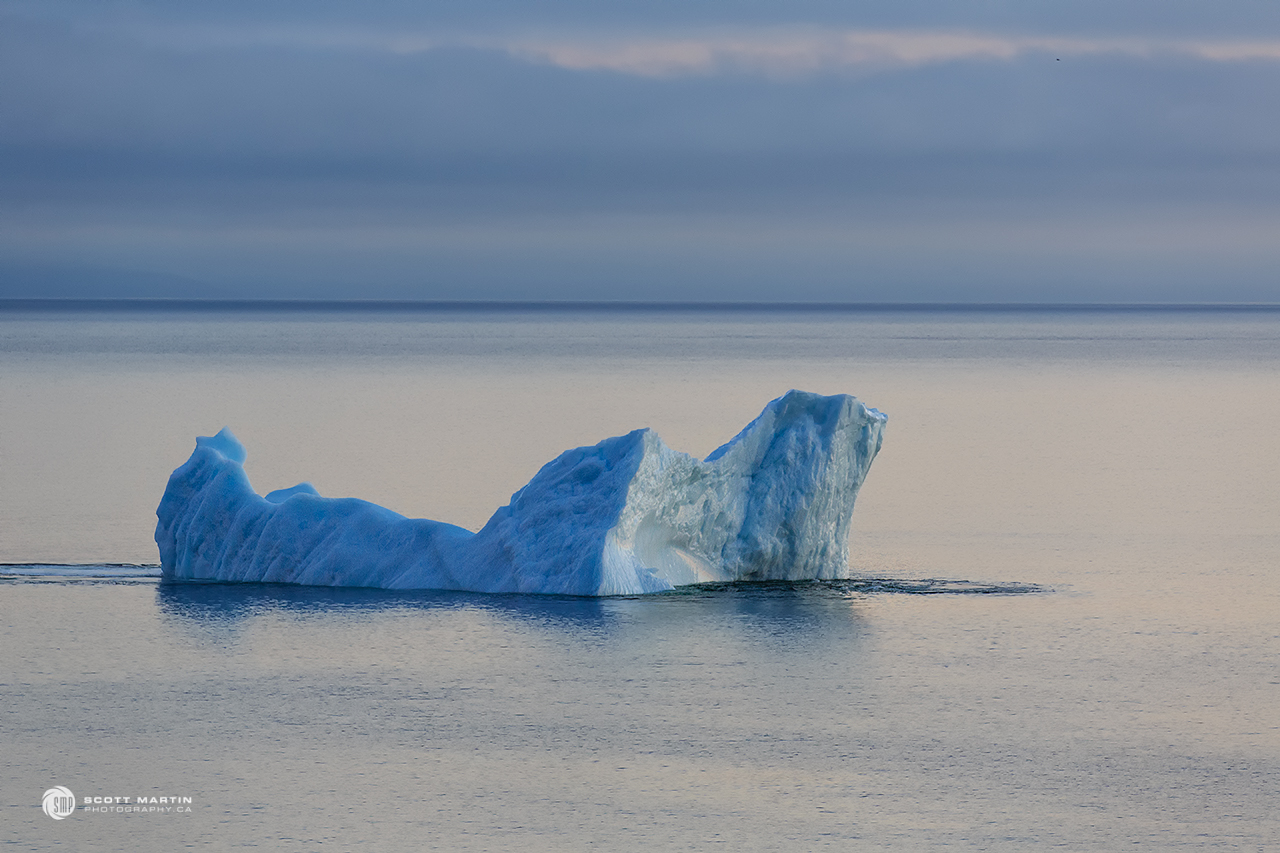
The image above shows the iceberg at its maximum rotation and now it slowly reversed its rotation and began to roll away from us. The unsettling of the iceberg caused another large pice of ice to flake off, as seen on the right side of the following image.
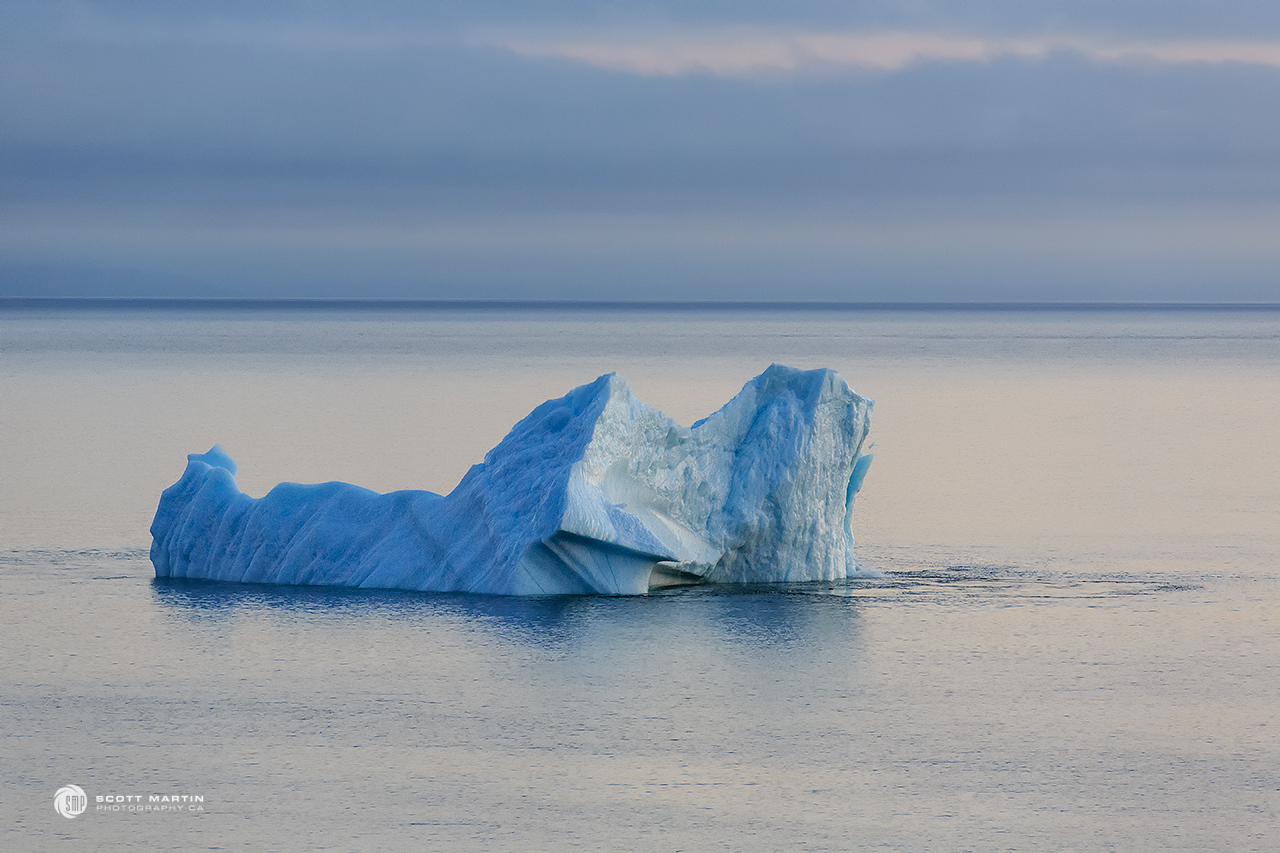
This was a huge pice of ice, at least thirty feet in height. The sound of the fragmentation and ensuing splash was a unique and unforgettable sound.
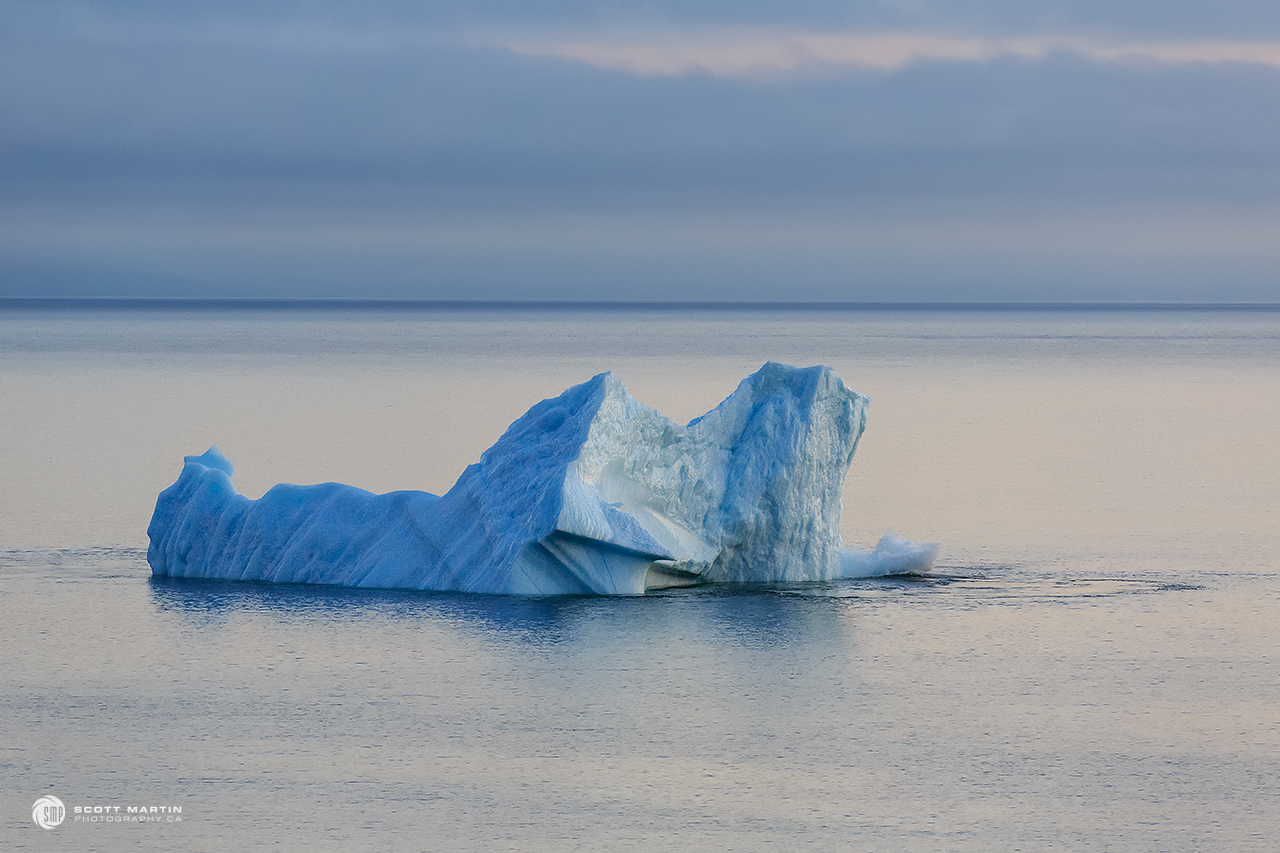
.
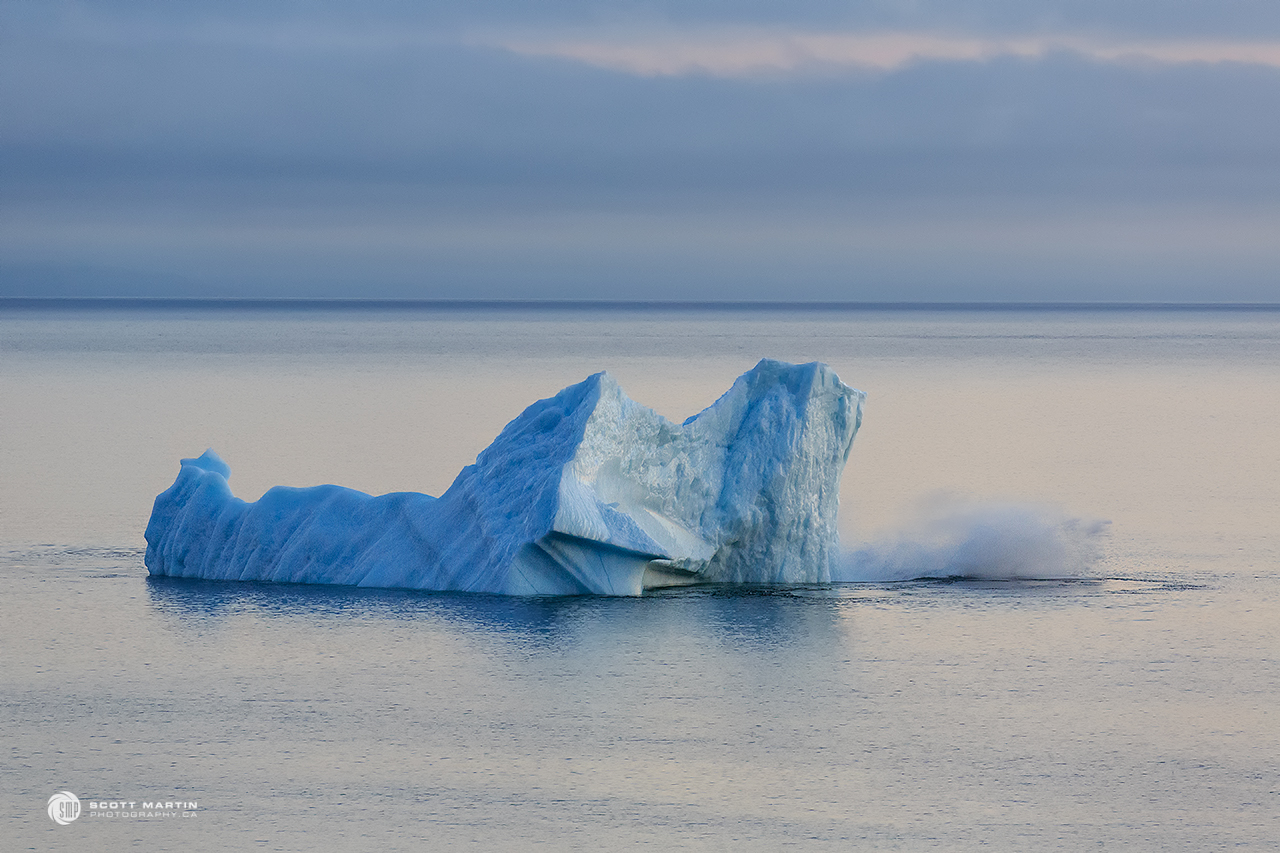
After the enormous splash, the iceberg silenced and the surrounding waters calmed.
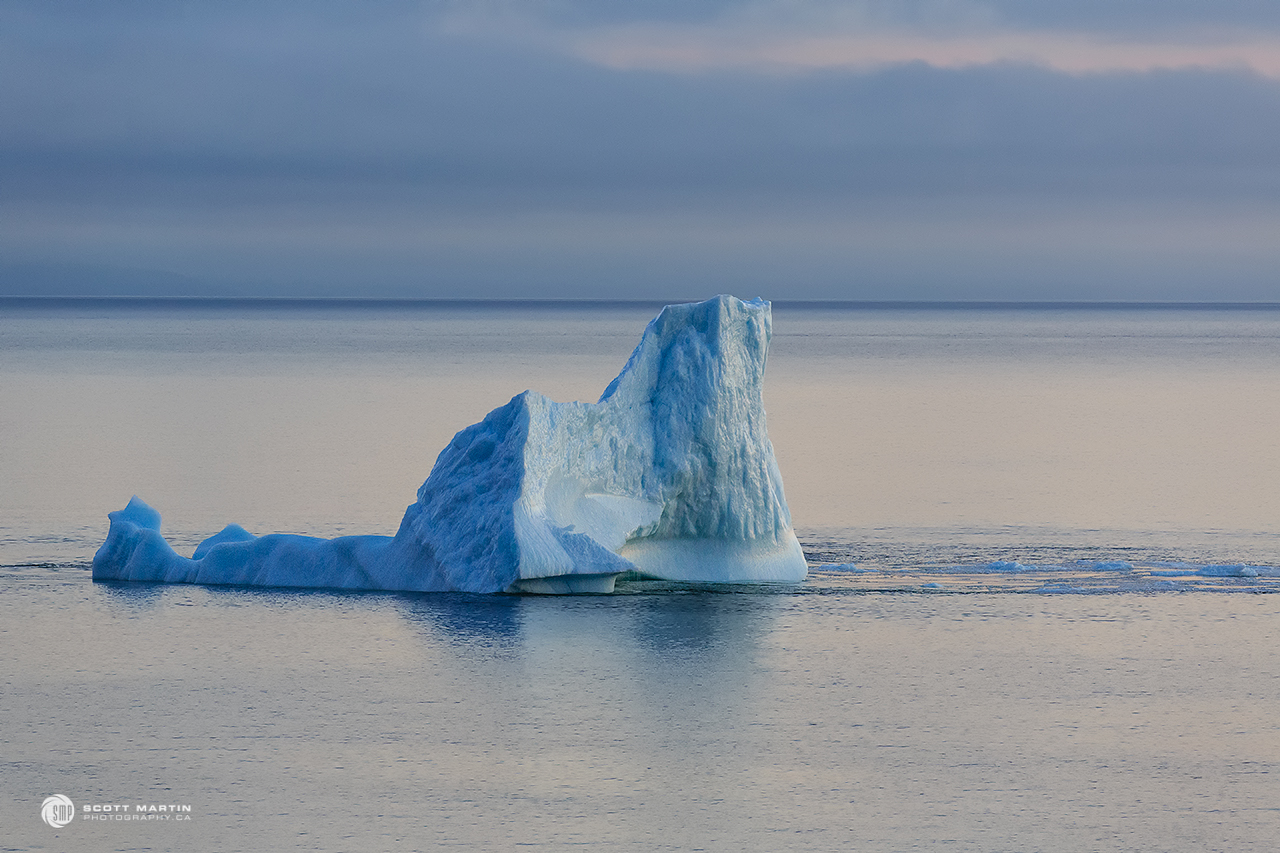
The previous images were taken over approximately ten minutes and by the end of that time the iceberg had loosed itself from the ocean floor 580′ below and slowly started drifting out into the North Atlantic. All of the images in the previous sequence were taken with the camera on a tripod so you can get a sense of how much the iceberg was moving by comparing its profile against the horizon.
When we left our hotel early in the morning, Deb & I had no idea we would be spending the entire day watching an iceberg, but what a day it was. Never having seen an iceberg before and then watching it break apart over the day and move out to sea was a highlight of the trip. We highly recommend when travelling to ‘The Rock’ that you schedule a time of the year you are likely to see some icebergs. They will never disappoint.
More images of icebergs can be found in the Iceberg Gallery while images from ‘The Rock’ can be found in the Newfoundland Gallery.
If you haven’t already done so, please subscribe to the blog and receive notification of future blog posts. The next two or three will be centred on Newfoundland; its rugged geography, old light houses, Puffins and Humpback Whales!
As we come to the end of another year, I’d like to thank all of you who have followed the blog. Your comments, support and encouragement are much appreciated. From our family to yours, a very Merry Christmas and Happy New Year.
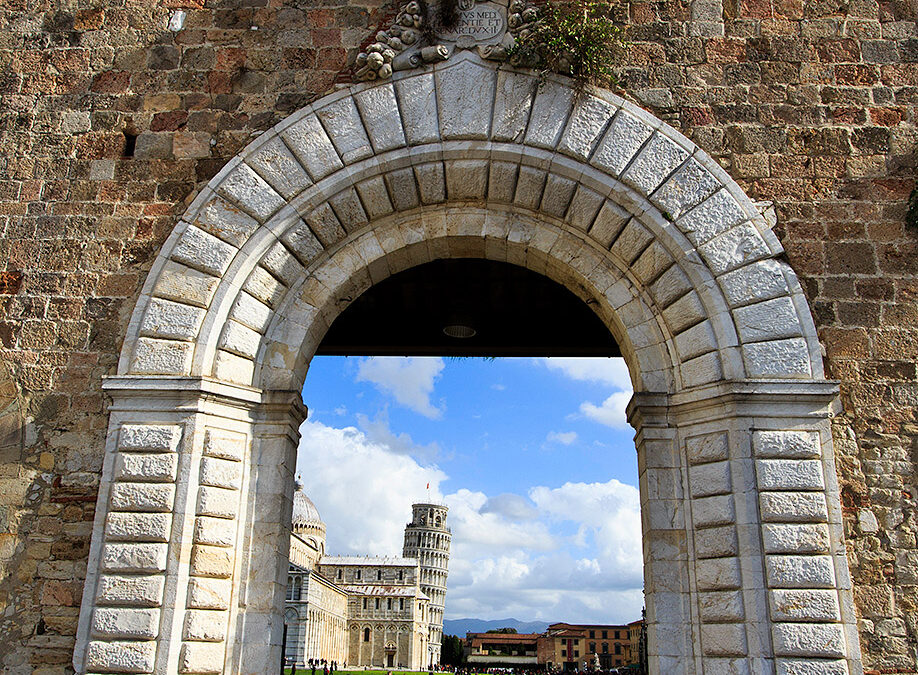
by Scott Martin Photography | Feb 10, 2017 | Blog, Cityscapes, Educational, Landscapes, Travel
The beautiful country of Italy is home to many unique and well known buildings with the Leaning Tower of Pisa being among the most iconic. As Deb & I left Cinque Terre and headed to the Amalfi coast for a few days in Positano we made it a point to stop and visit the Leaning Tower.
Pisa is a coastal city of over 90,000 people in the famous Italian region of Tuscany. The Leaning Tower of Pisa is a free standing bell tower, or campanile, of the Pisa Cathedral. The partially walled grounds of the cathedral have three primary buildings; the cathedral, the baptistery and the campanile. As we approached one of the gateways to the campus we experienced our first glimpse the Leaning Tower. One of the many joys of travel is the feeling engendered when seeing an iconic landscape or building in person for the first time and this image captures that moment with the famous bell tower.
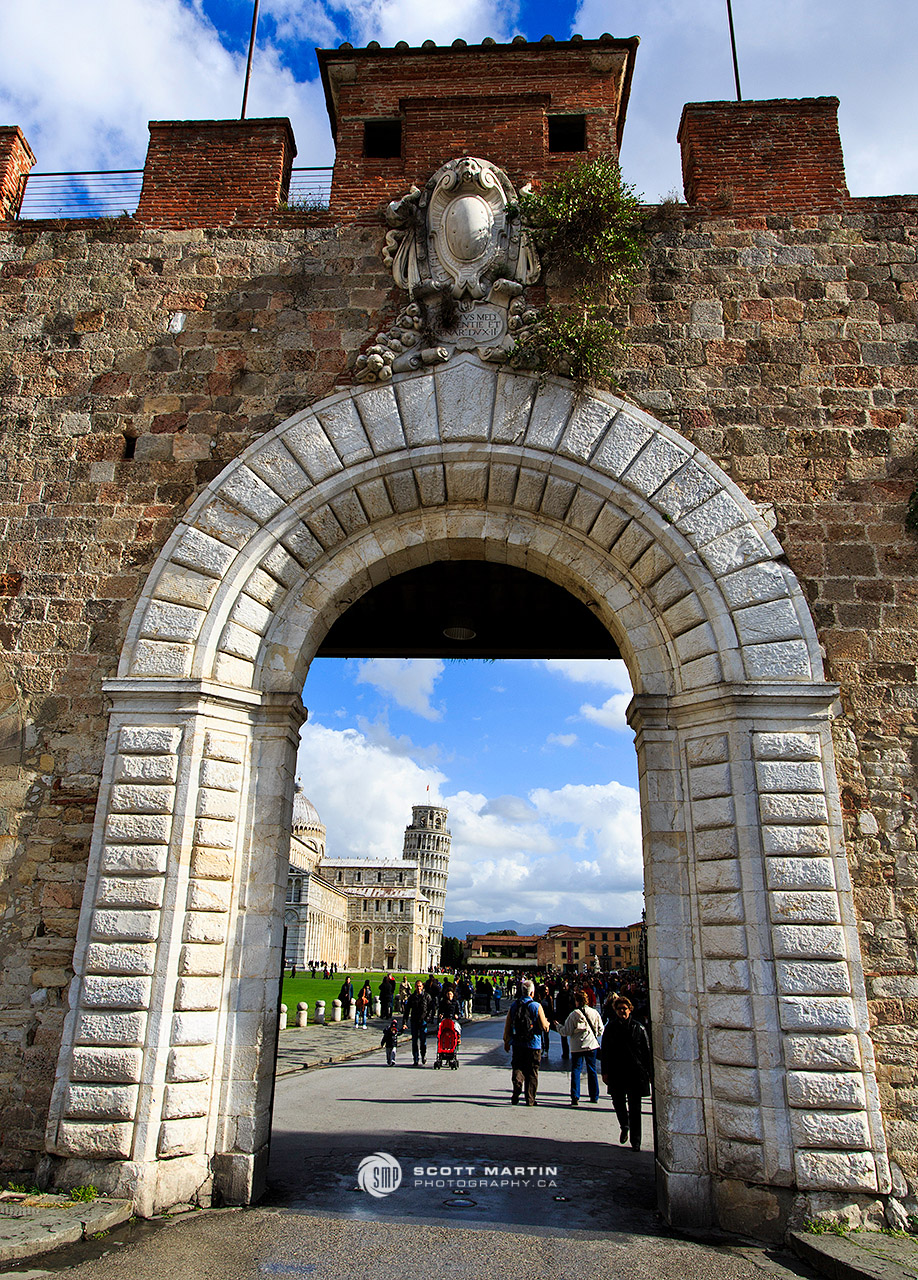
The tower is ~185 feet high and took many many years to complete. The tilting of the tower began to occur during its initial construction primarily due the sandy ground on one side of the tower being too soft to support the extreme weight of the structure (14,500 metric tons).
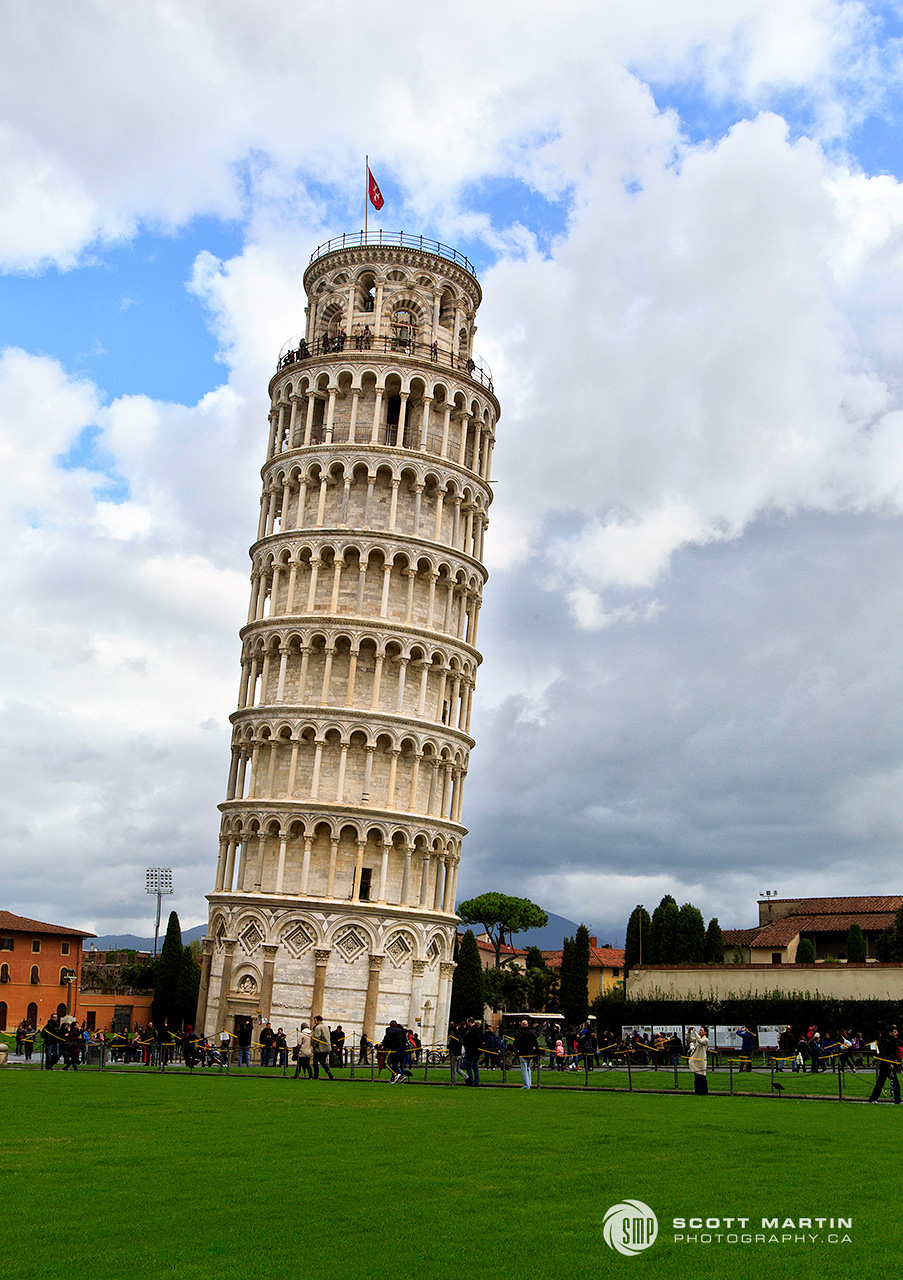
The walls at the base of the tower are made of solid white marble and are an incredible eight feet thick in order to create a sufficient support on which to build the seven stories above. Unfortunately, the ground below didn’t do as well! It’s hard to believe that the below grade foundation is only ten feet deep for a structure that is almost 200′ high. Certainly the design of the tower was flawed from the outset.
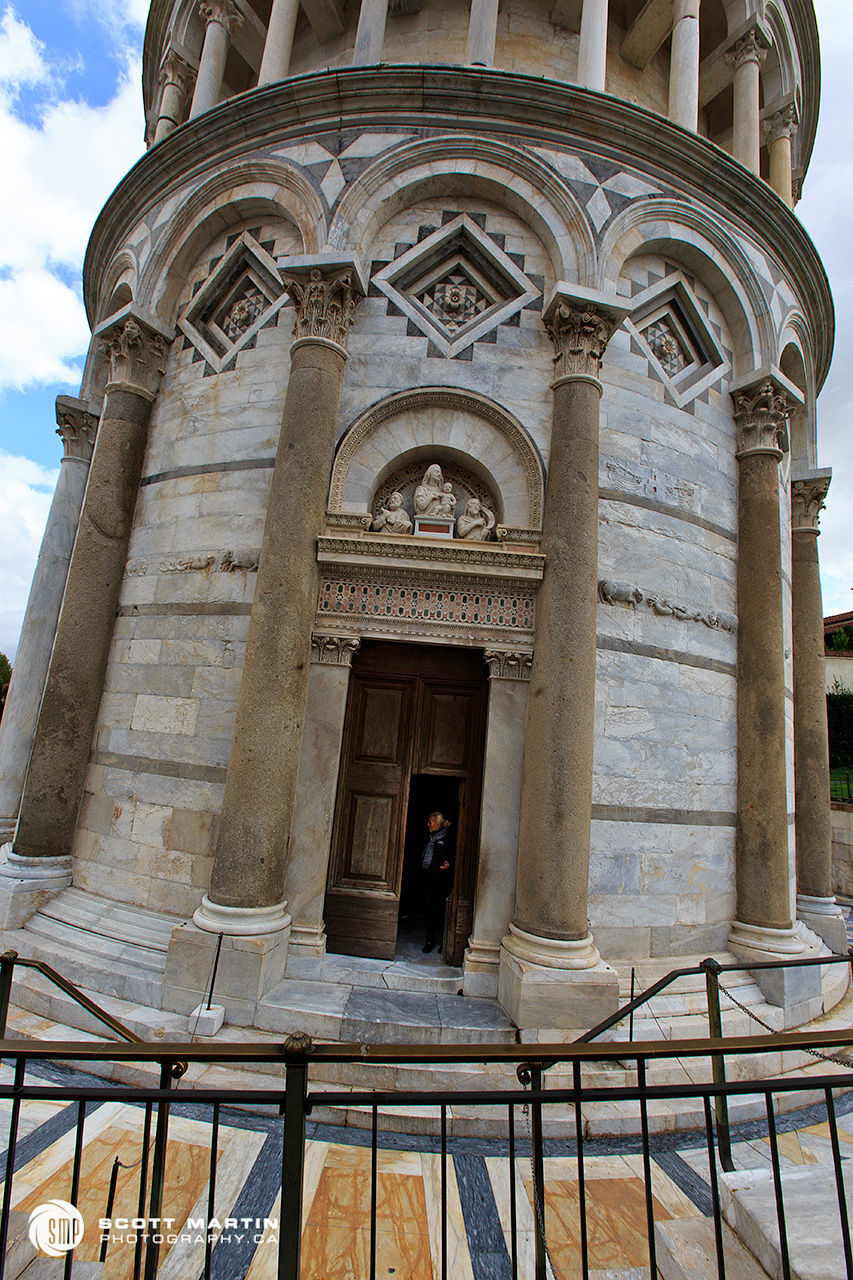
Construction of the tower began on August 14, 1173 and wasn’t completed until 1372 when the bell chamber was finished atop the tower 199 years after the ground breaking. Recent cleaning and surface restoration of the tower removed centuries of dirt & grime from the industrial revolution which had darkened the tower to a dirty grey colour. This next image shows the beautiful white sunlit marble against a stormy dark back ground. It really is a beautiful structure.
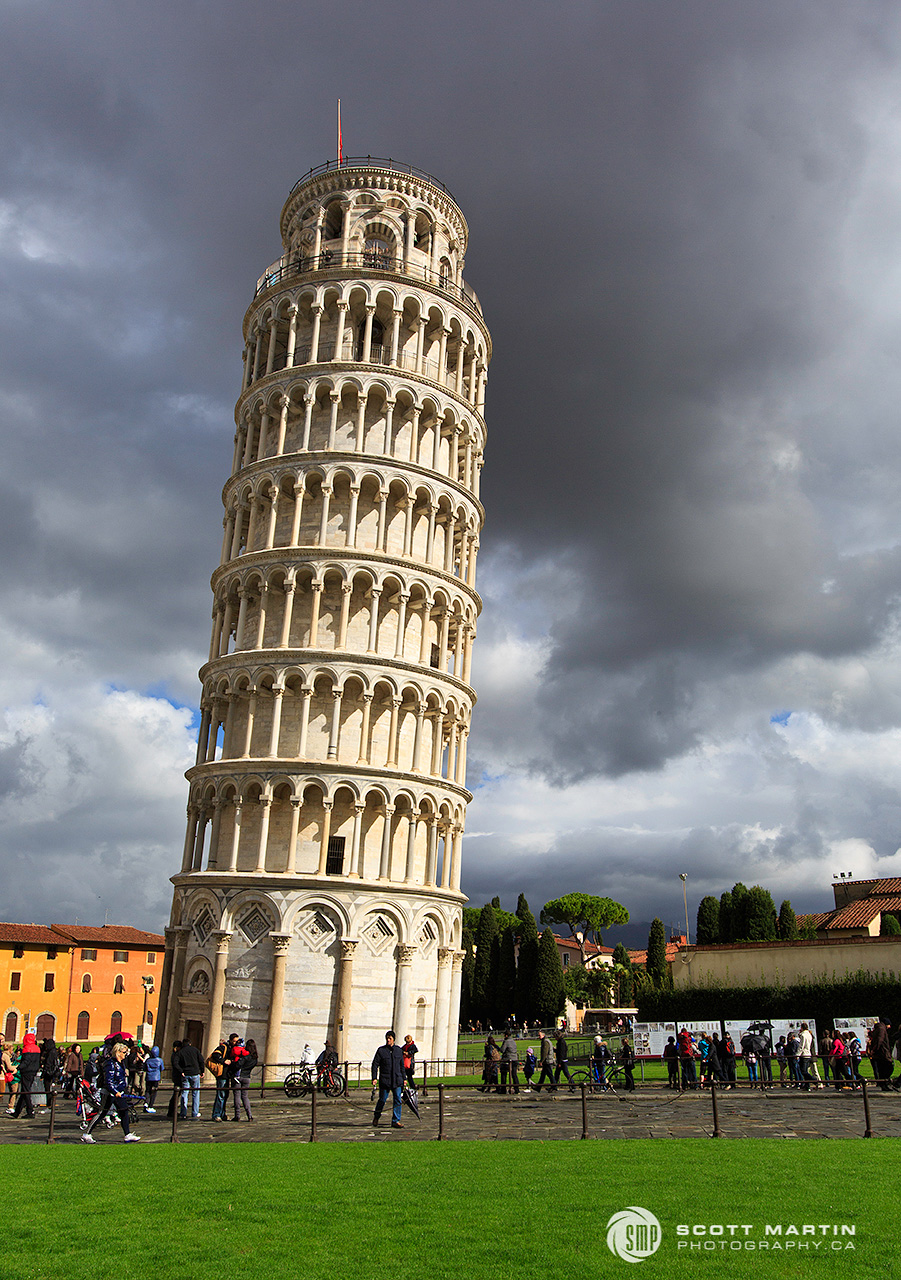
By 1990 the tower’s lean reached 5.5° and the campanile was closed to the public. Steel guy wires were attached to the third level, the seven bells were removed from the bell chamber and nearby apartment buildings were evacuated due to fear of spontaneous toppling of the tower. Between 1990-2001 the tower was straightened and stabilized. This was accomplished by removing 1350 cubic feet (77 tons) of earth from below the high side of the foundation. This restored the lean of the tower to about 3.9° which it was in the late nineteenth century. The decision was made not to place the tower in a vertical orientation largely due to tourism considerations. Its present lean means that the centre point at the top of the tower is 12’10” from the centre point at the base.
Although this next image has not been manipulated, it was taken at a focal length of 16mm on a full frame camera and the native optics of the lens creates an exaggerated perspective of the tower.
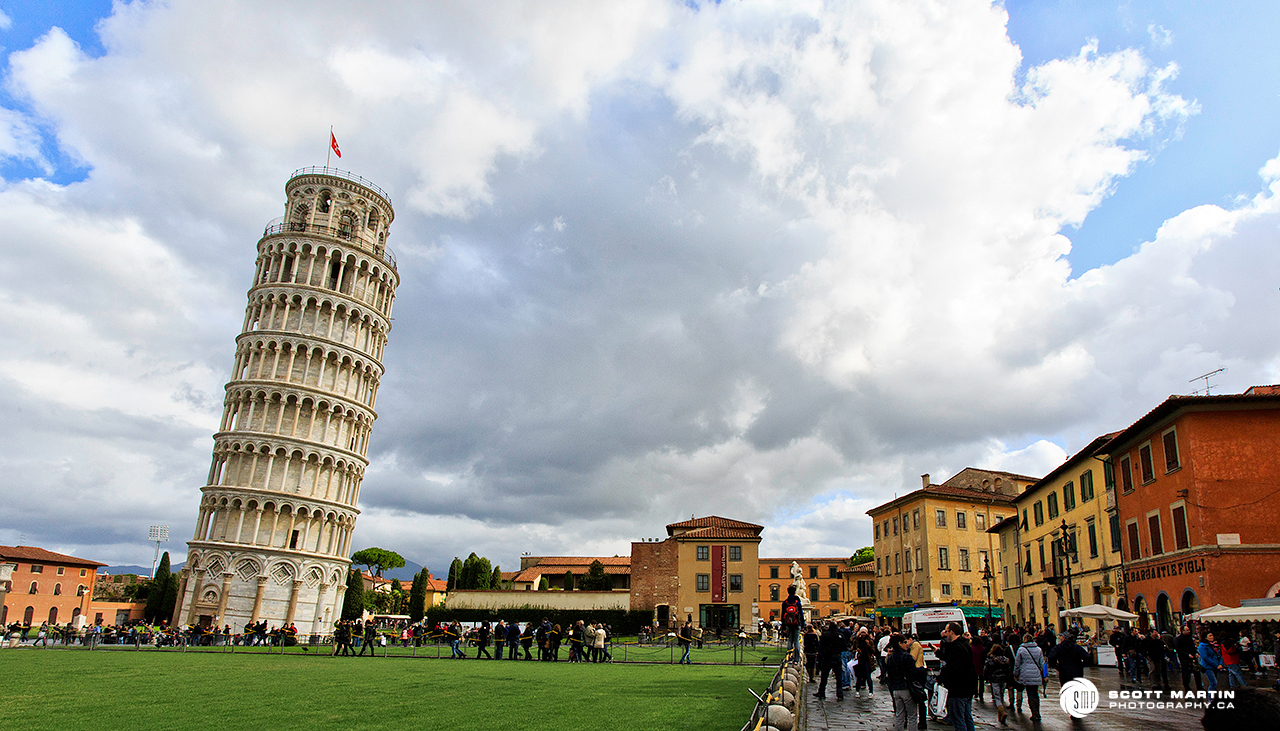
The Pisa Cathedral is an impressive structure in its own right, designed in the shape of a latin cross and constructed of white & grey marble. The cathedral began construction in 1063 and was completed in 1092.
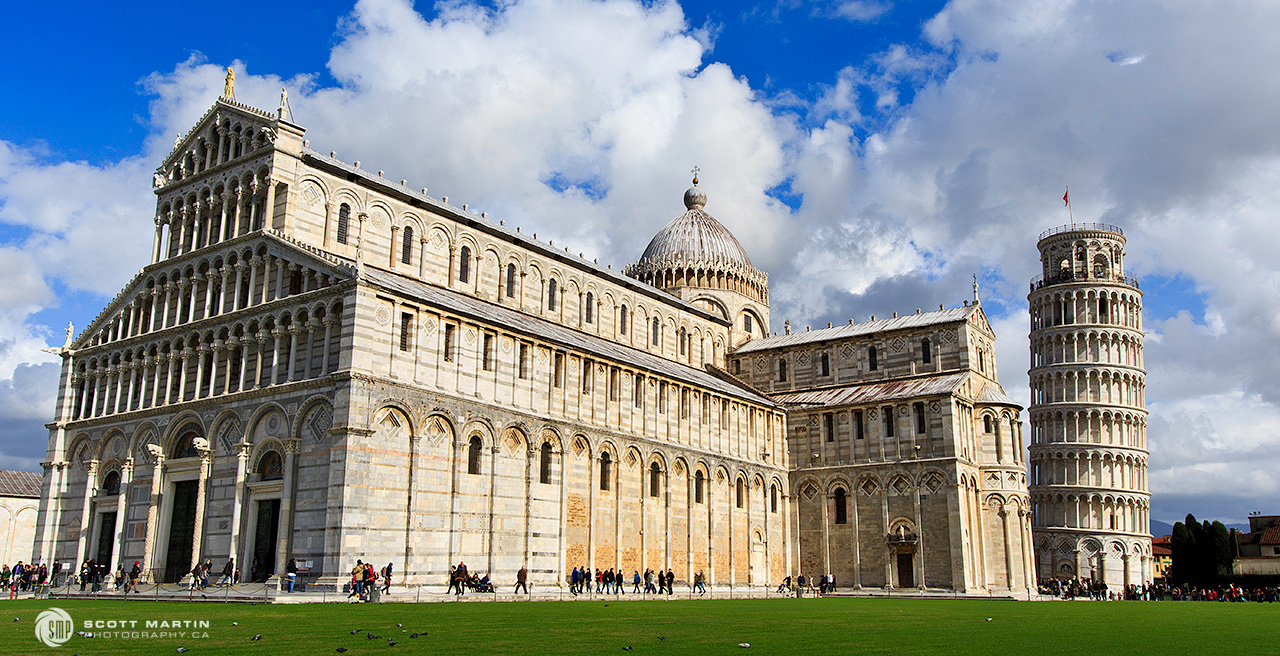
It’s hard to believe when walking through the campus that these buildings are almost one thousand years old.
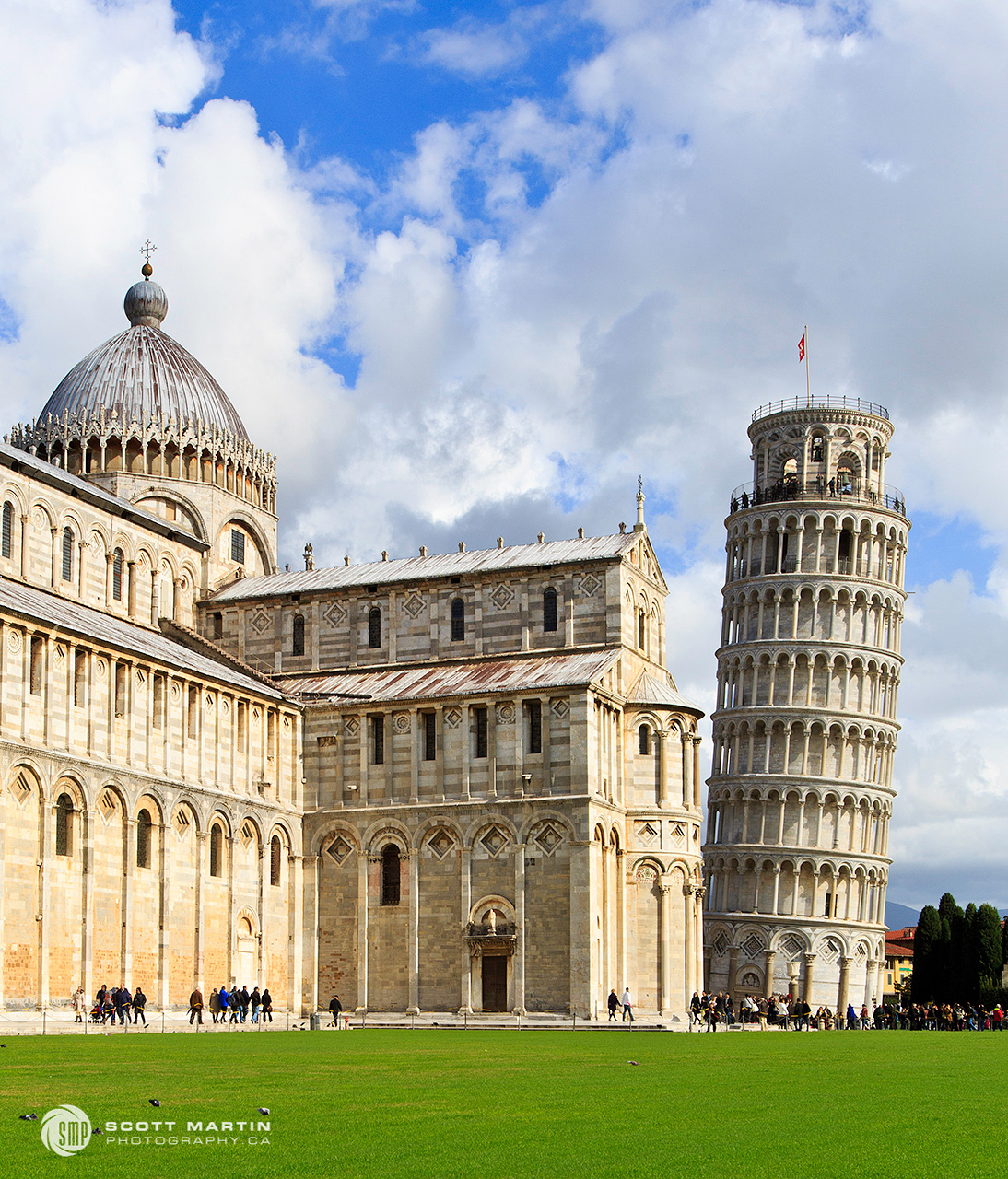
The third major building on the cathedral grounds is the baptistery. It was the second structure chronologically, with construction starting in 1152 and completed in 1363, two hundred and eleven years later. The Pisa Baptistery is the largest in Italy and like the adjacent structures is constructed of marble. The interesting thing to note when looking at the baptistery is the different architectural styles of the building, presumably a result of the 200+ years it took to build. The base of the building is in Roman styling with rounded arches above the columns while the upper sections of the building are of gothic styling with pointed arches atop the columns.
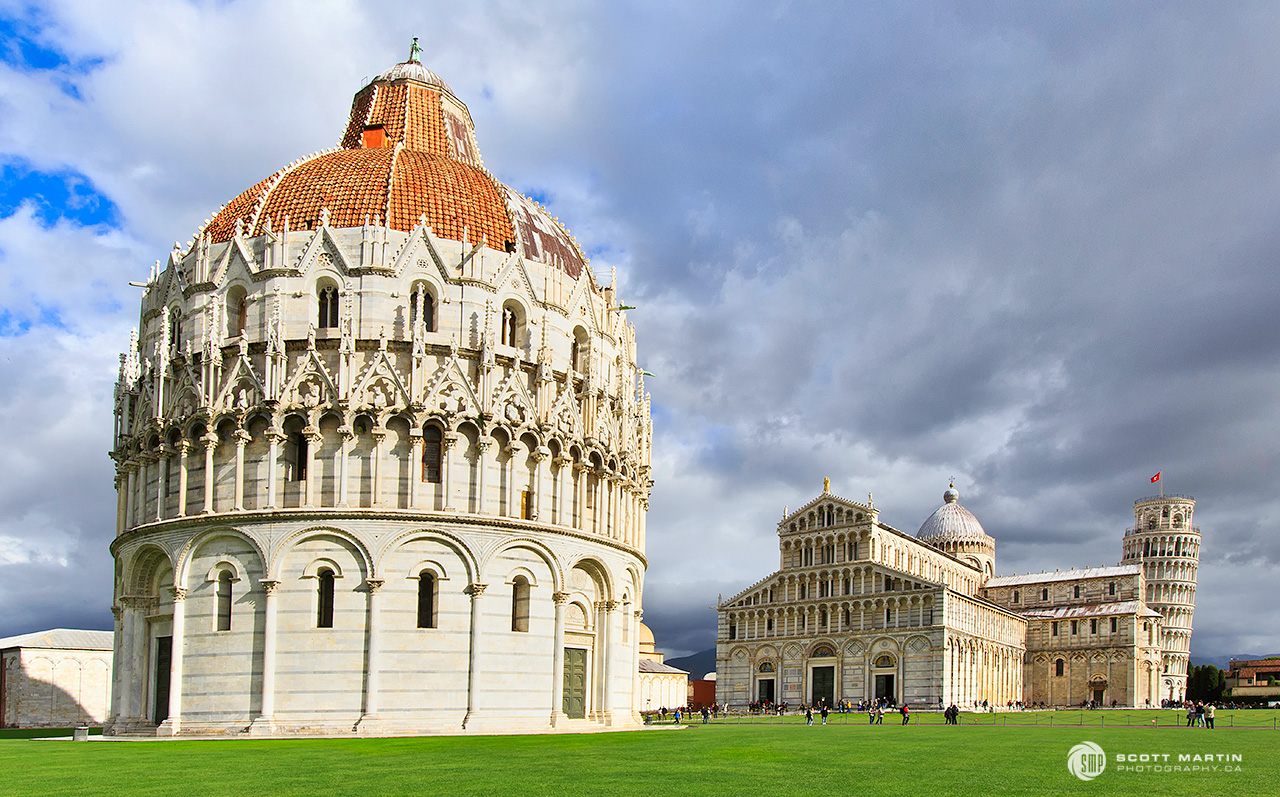
The baptistery also has a relatively small foundation and shares the sandy earth of the cathedral & bell tower so it also leans, however an almost imperceptible 0.6° towards the cathedral.
Although we only spent a few hours visiting Pisa, it was a great time and a pleasure to see and learn a little about its iconic landmark.
Deb & I couldn’t help taking some classic tourist shots of the tower while we were there. As a photographer, one always looks for that ‘original shot’, especially of the well known landmarks…..I’m quite certain these next two images don’t qualify 🙂
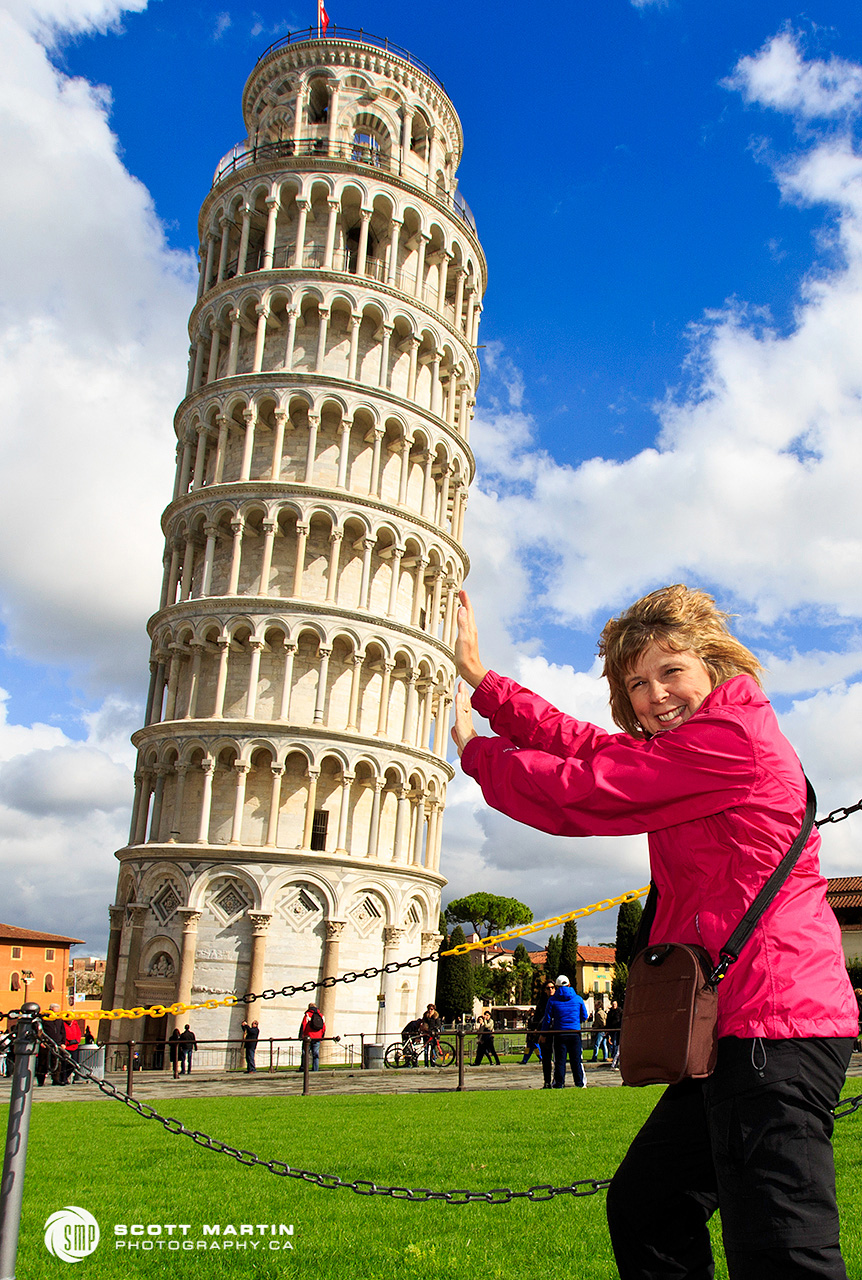
.
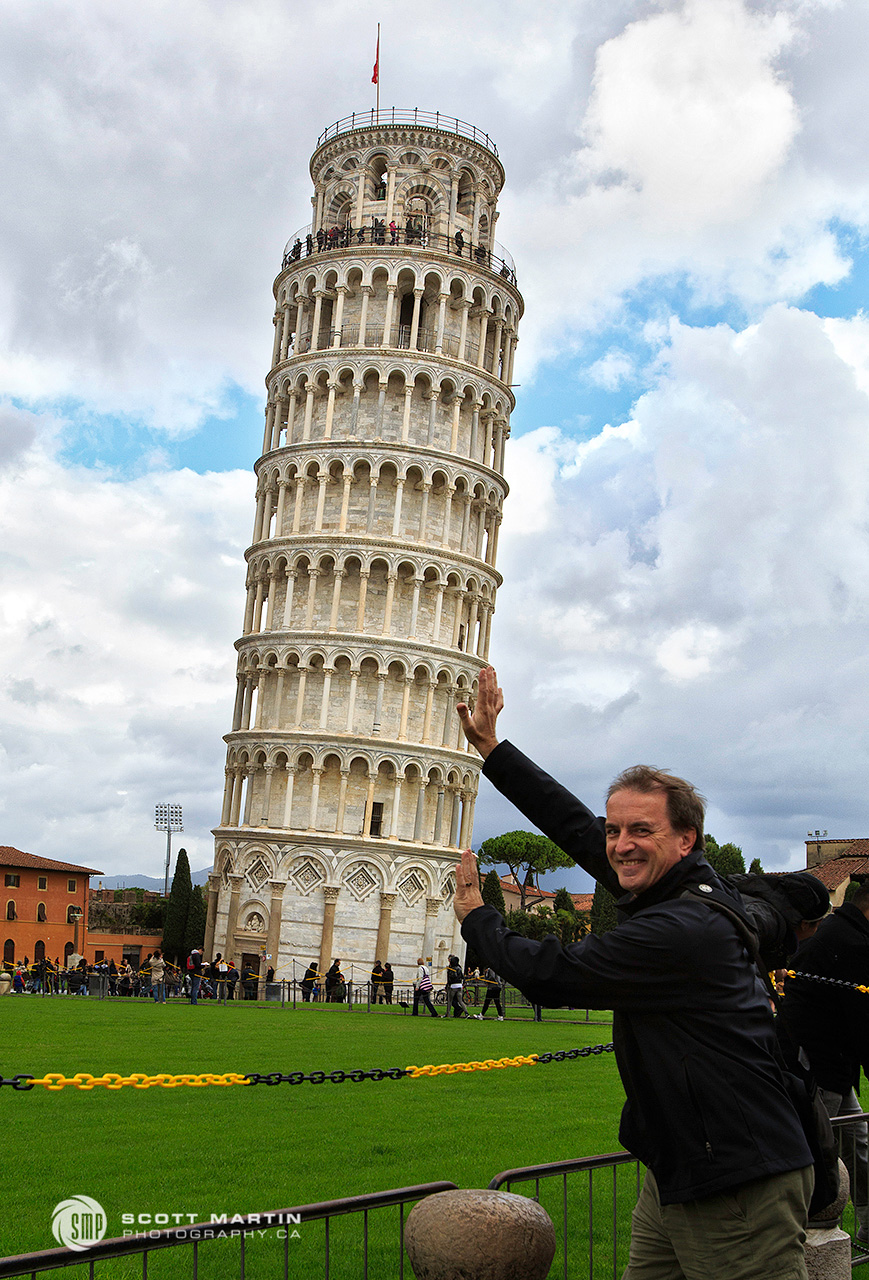
Other images from Pisa can be seen by clicking on this link plus there are a number of other galleries from various locations in Europe that are also posted on the website.
All of the images in this post were taken using a Canon 5D Mk III and EF 16-35 f2.8 wide angle zoom lens.
Thanks for taking the time to read through this post and I trust you’ve enjoyed the Leaning Tower of Pisa. As always you comments and questions are much appreciated.
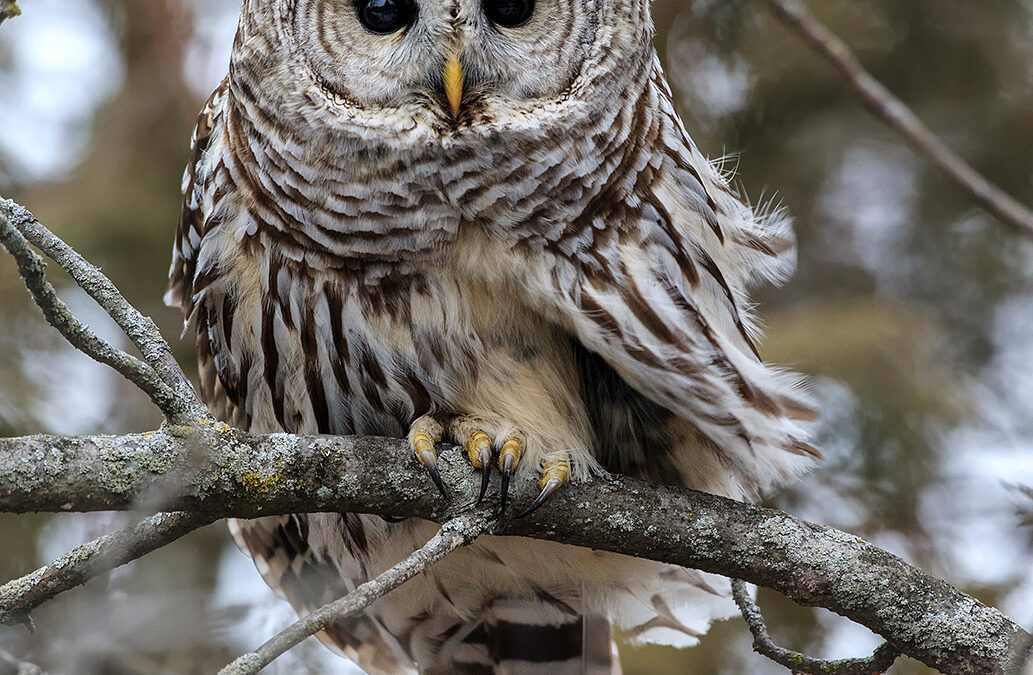
by Scott Martin Photography | Jan 7, 2017 | Birds, Blog, Raptors, Wildlife
Last Saturday marked the last day of 2016 and although very overcast, cold and windy, provided the last opportunity to photograph some birds for another year. The intent was to set up a perch and photograph the little birds that frequent our area in the winter months. While setting things up, a Barred Owl flew in, perched in a nearby tree and immediately became the photographic focus for the next forty minutes until it flew off after being flushed by a White tailed Deer that passed under its perch.
Barred Owls are probably Ontario’s most common owl and are relatively easy to find. They are non-migratory and intact don’t move around very far from their place of birth. In fact in one study of more than 150 Barred Owls, none were found to have moved further than six miles over the course of the research.
It was quite windy on New Years Eve which adds an interesting perspective to this first portrait.
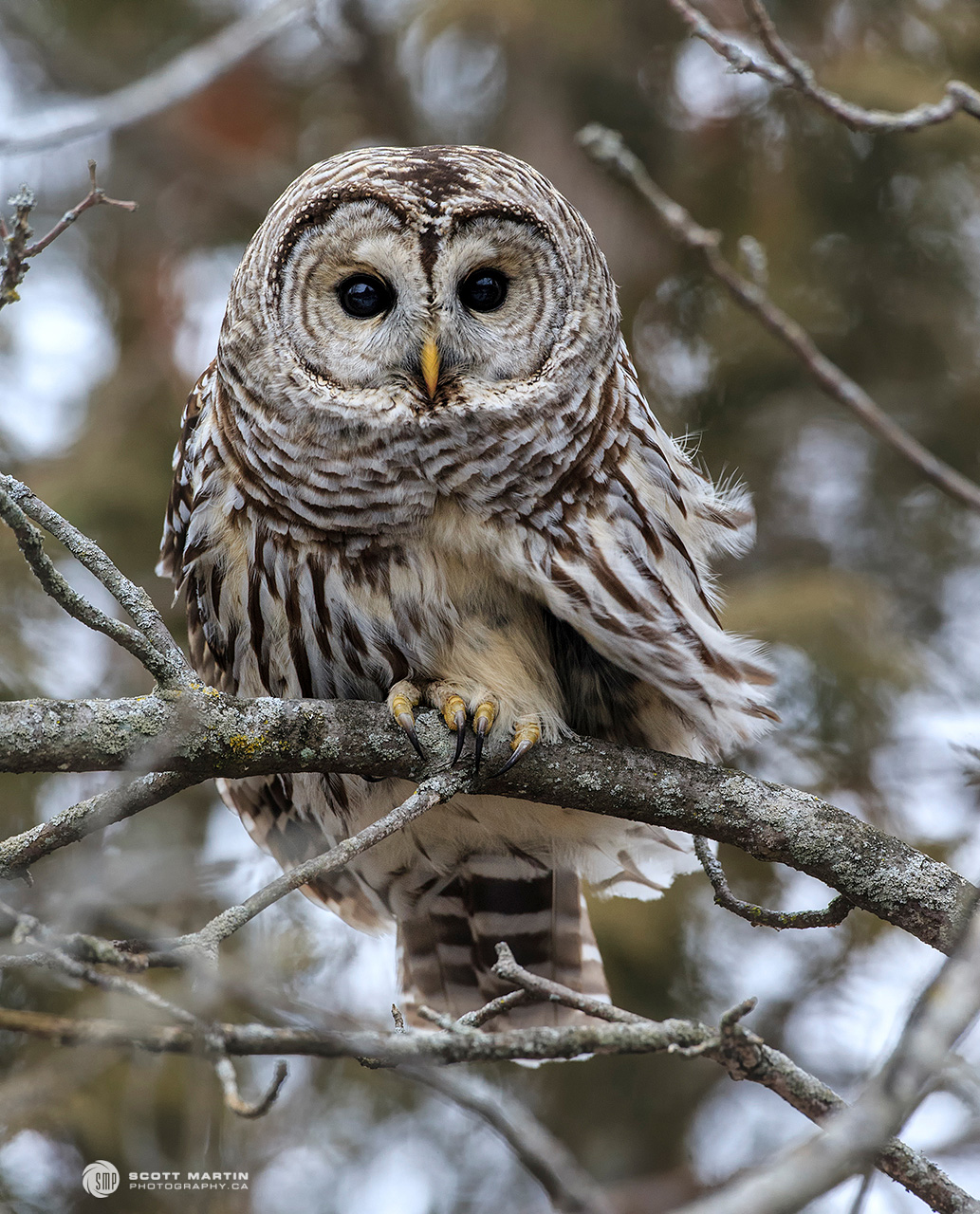
Barred Owls are easily identified by their large size, black eyes and lack of ear tufts.
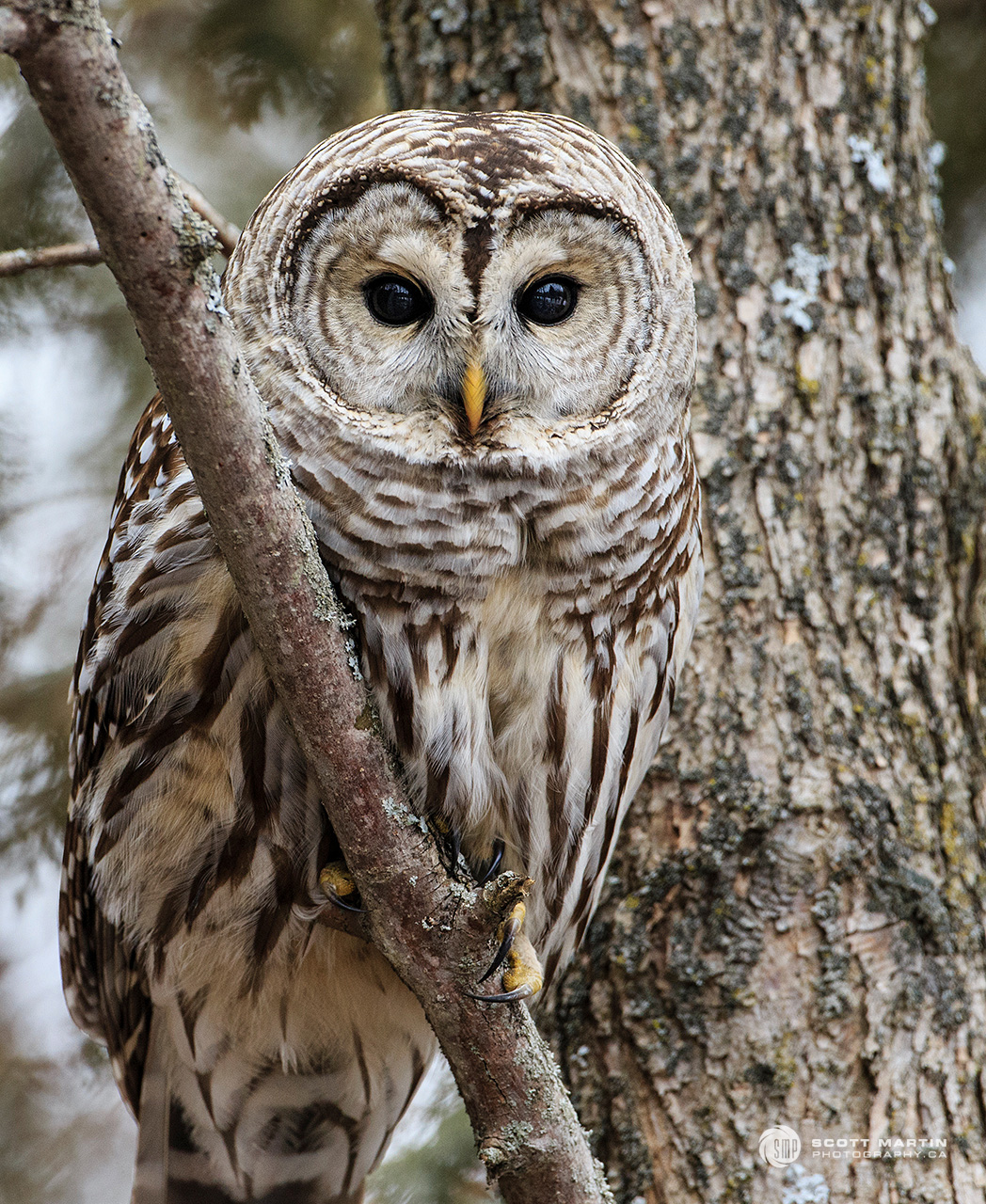
Typical adults are similar in size and appearance, with an approximate length of 20″ and a wingspan approaching four feet. Barred Owls weigh about 35 ounces.
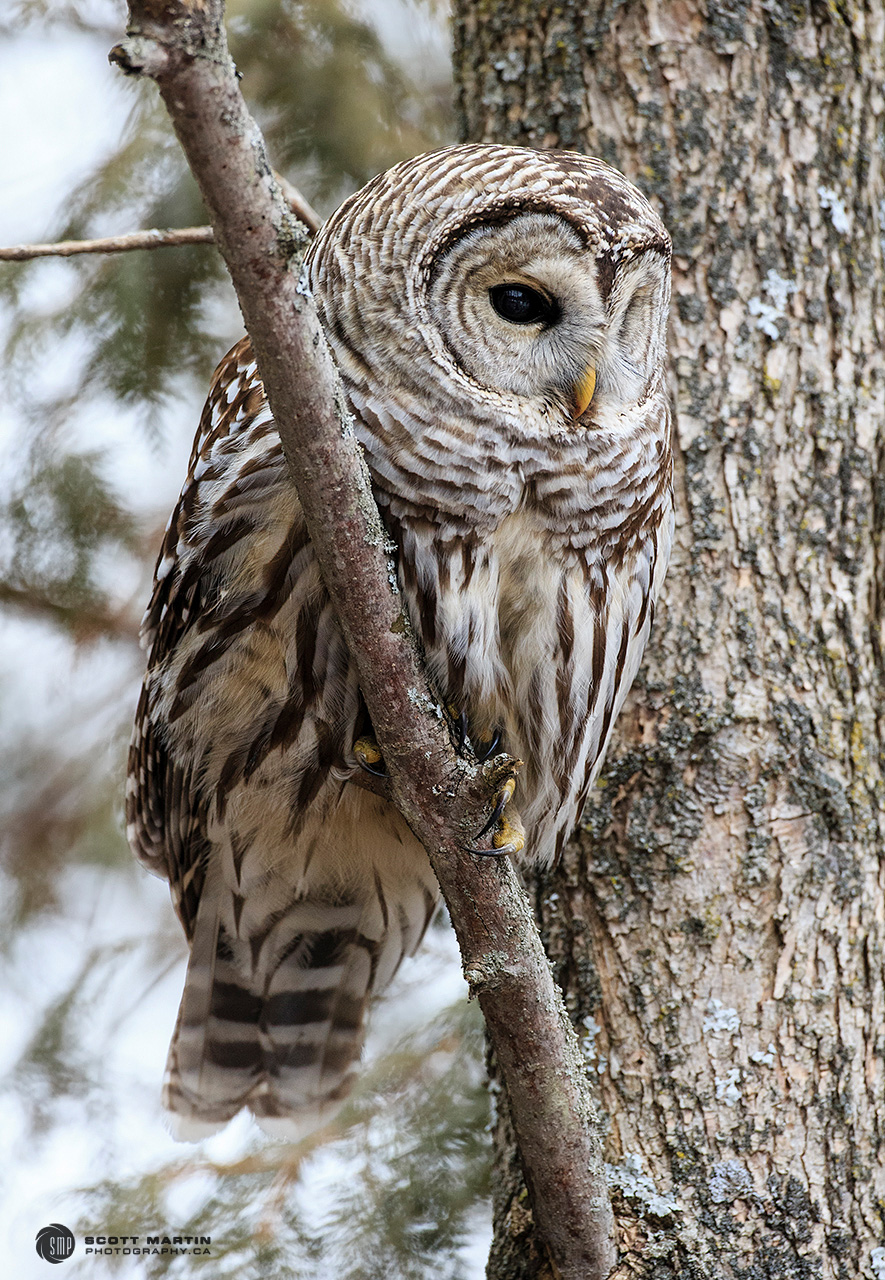
Owls rely on their feathers to insulate and protect their bodies and the detail and extent of the feathers is especially evident around the eyes and facial discs. This next image is included simply to show that even the eyelids are composed of layers of feathers.
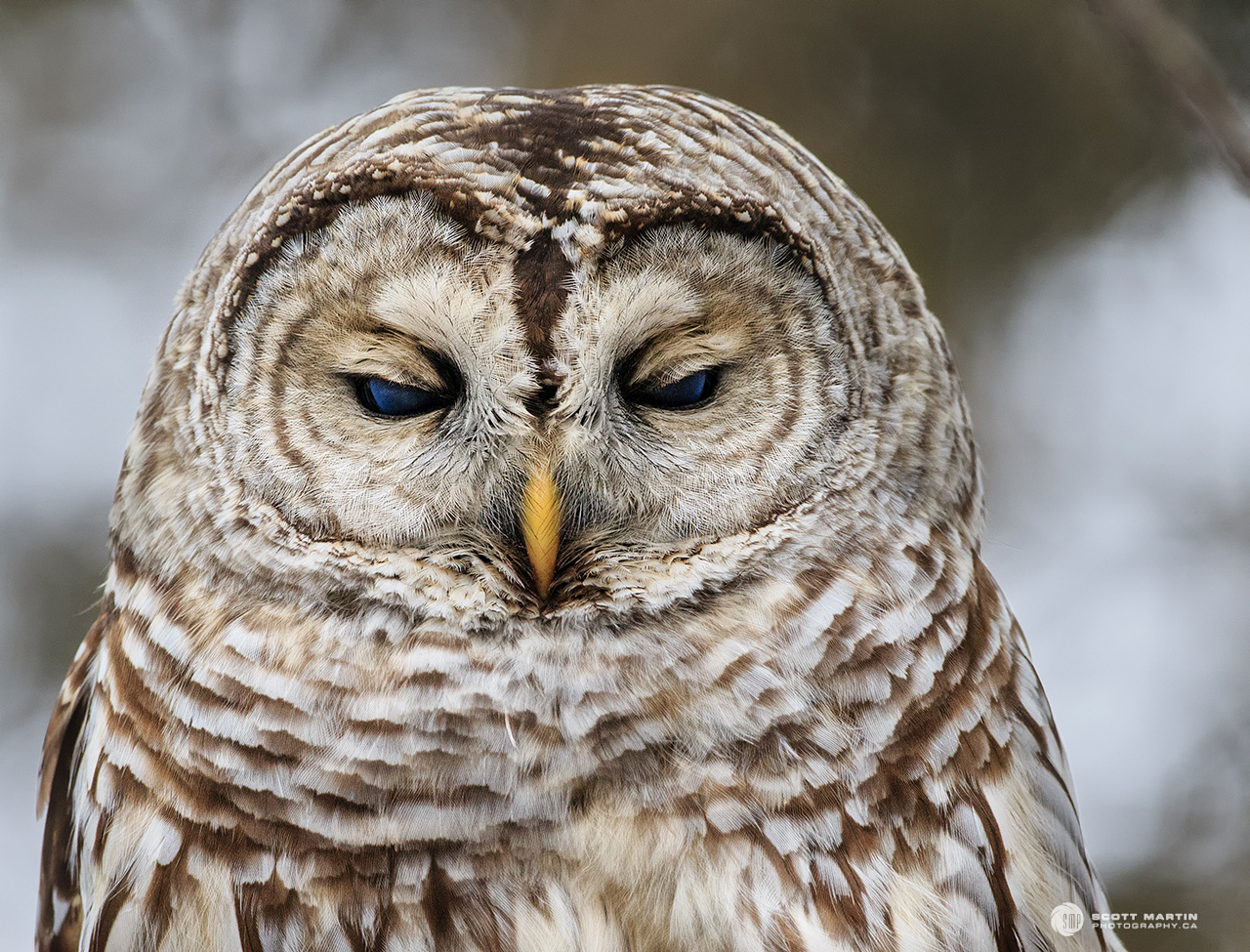
The following tight profile view shows the amazing feather detail of the periorbital region of the Barred Owl as well as providing an interesting and almost artistic perspective.
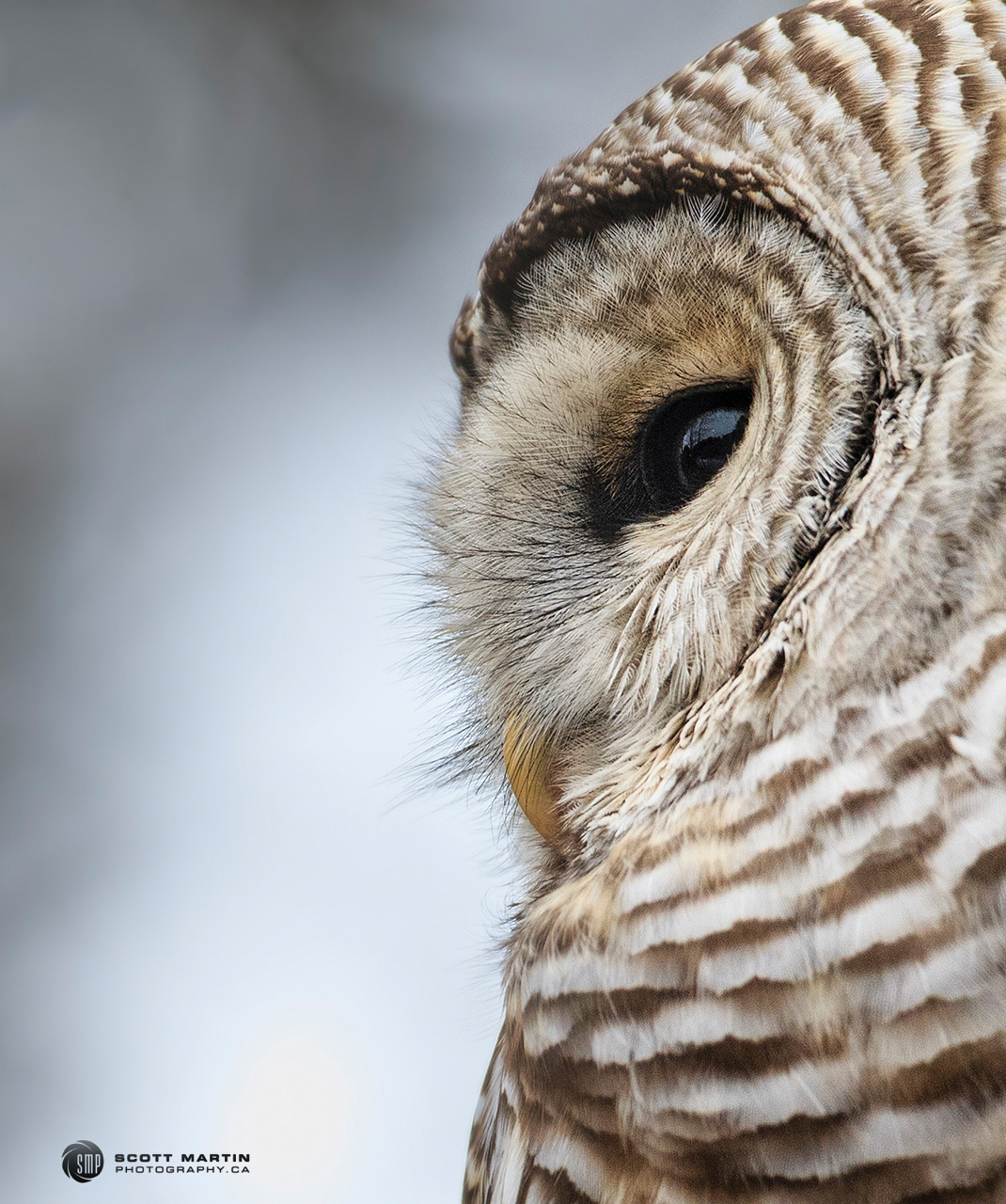
The owl perched not twenty feet from where I was located requiring me to move away about the same distance in order to fit the full bird into the frame. Before moving back I was able to take the tight shots above, while the next two images are significant crops. (‘Crops’ are smaller portions of an original image that are created when processing images on the computer).
The beautiful and haunting dark-eyed stare of a Barred Owl.
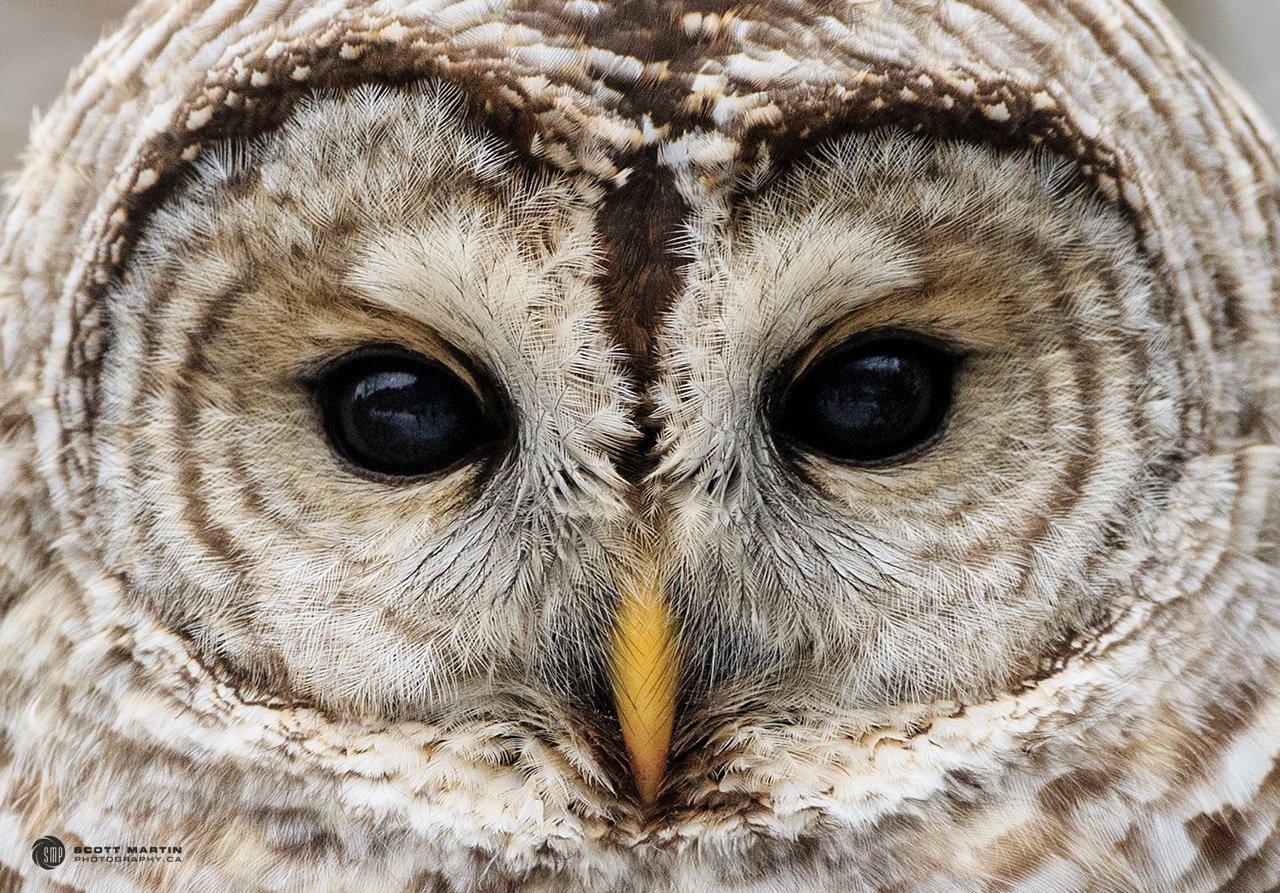
Talons….the weapons of mouse destruction 🙂
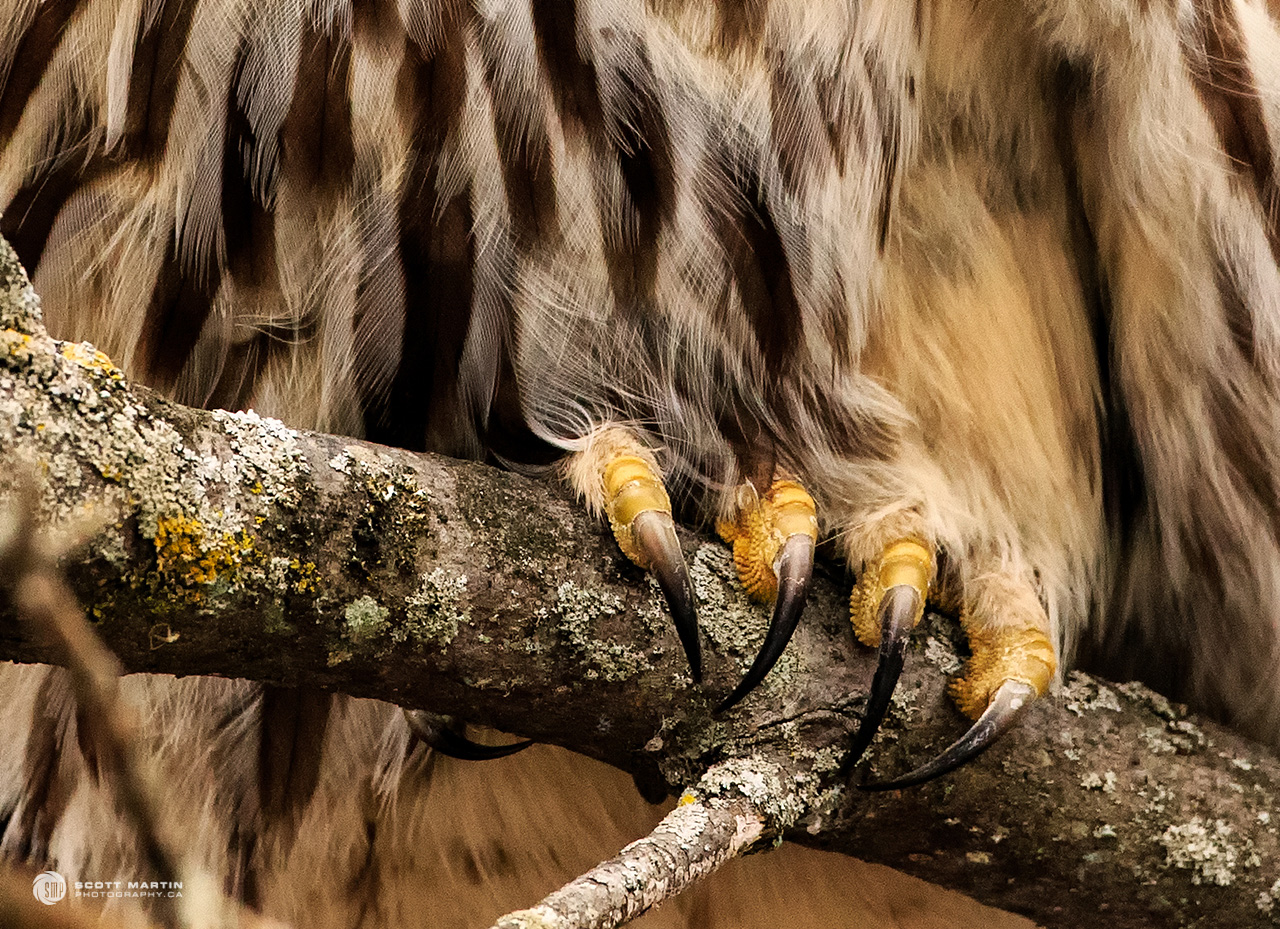
Barred Owls eat a wide range of animals including fish, invertebrates, squirrels, rabbits, chipmunks and birds up to the size of a partridge. Their staples are voles and mice. Barred Owls hunt from a perch, intently staring and listening for the next meal opportunity to pass below. This last image shows a Barred Owl in a classic hunting pose.
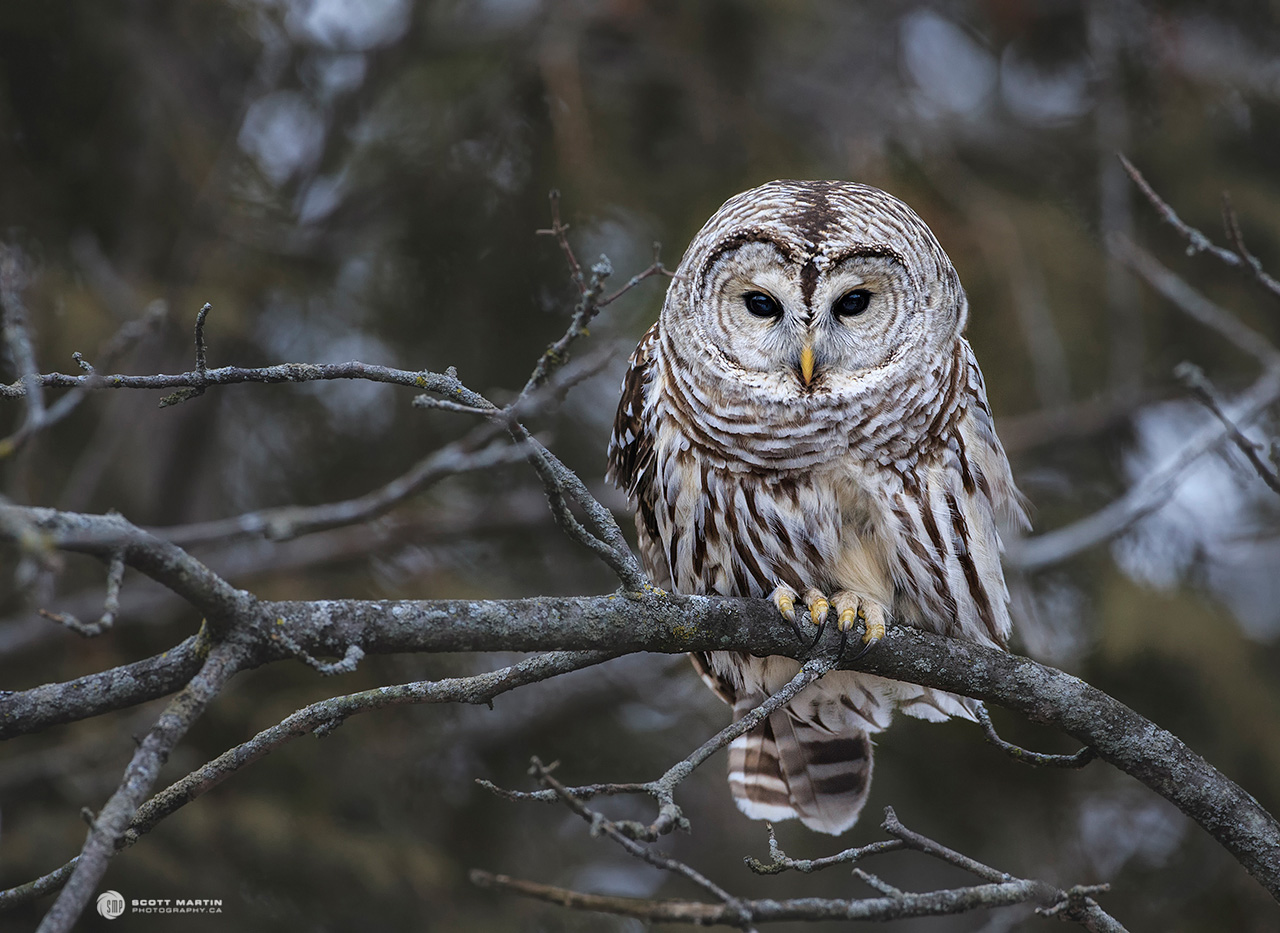
Its hard to believe that another year has passed quickly by and I would like to thank you for taking the time to follow this blog. It is much appreciated as are your comments and questions.
More Owl images can be viewed by following this link to the Owls Gallery.
All of the images in this blog post were taken with a Canon 1Dx and EF 500 f4 L IS lens.

















































Follow Scott Martin Photography